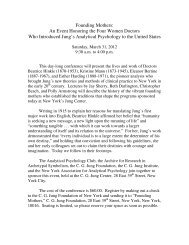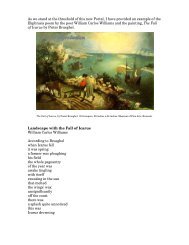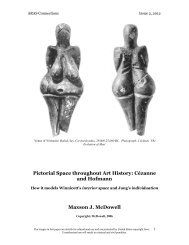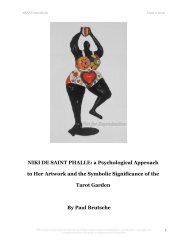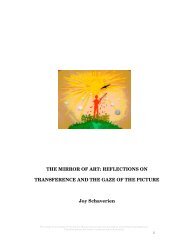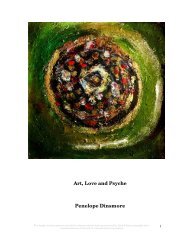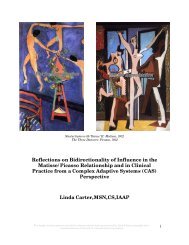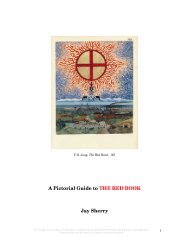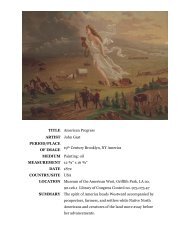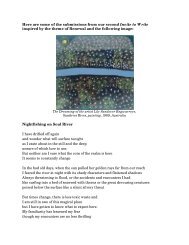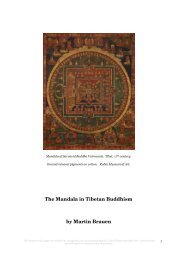Labyrinth of the Shadow: History and Alchemy in Adolph ... - ARAS
Labyrinth of the Shadow: History and Alchemy in Adolph ... - ARAS
Labyrinth of the Shadow: History and Alchemy in Adolph ... - ARAS
You also want an ePaper? Increase the reach of your titles
YUMPU automatically turns print PDFs into web optimized ePapers that Google loves.
Figure 1 - The Prisoners by <strong>Adolph</strong> Gottlieb, 1947.<br />
<strong>Labyr<strong>in</strong>th</strong> <strong>of</strong> <strong>the</strong> <strong>Shadow</strong>: <strong>History</strong> <strong>and</strong> <strong>Alchemy</strong> <strong>in</strong><br />
<strong>Adolph</strong> Gottlieb’s The Prisoners<br />
Michael J. L<strong>and</strong>auer <strong>and</strong> Bruce Barnes<br />
PART 1<br />
THE PRISONERS, 1947 by ADOLPH GOTTLIEB:<br />
A Systematic Symbolic Interpretation<br />
by Michael J. L<strong>and</strong>auer
<strong>ARAS</strong> Connections Issue 3, 2011<br />
I first met this pa<strong>in</strong>t<strong>in</strong>g at <strong>the</strong> Wadd<strong>in</strong>gton-Shiell Gallery <strong>in</strong> Toronto <strong>in</strong><br />
1979. Miriam Shiell had brought The Prisoners over for <strong>the</strong> season’s open<strong>in</strong>g<br />
show from Leslie Wadd<strong>in</strong>gton’s London Gallery. The Prisoners dom<strong>in</strong>ated its<br />
space <strong>and</strong> bowled me over with its larger than life presence. It brooded gloom,<br />
spat menace, radiated stubborn hope. I fell <strong>in</strong> love immediately.<br />
In 1945 Gottlieb wrote <strong>in</strong> <strong>the</strong> New York Times, “Pa<strong>in</strong>t<strong>in</strong>g is <strong>the</strong> mak<strong>in</strong>g <strong>of</strong><br />
images. All pa<strong>in</strong>ters strive for <strong>the</strong> image but some produce only effigies. This<br />
outcome is not determ<strong>in</strong>ed by <strong>the</strong> degree <strong>of</strong> resemblance to natural objects;<br />
ra<strong>the</strong>r it is by <strong>the</strong> <strong>in</strong>vention <strong>of</strong> symbols transcend<strong>in</strong>g resemblance that<br />
imagery is made possible. If <strong>the</strong> pa<strong>in</strong>ter’s conception is realized <strong>in</strong> <strong>the</strong> form <strong>of</strong><br />
an image, we are confronted with a new natural object which has its own life, its<br />
own beauty <strong>and</strong> its own wisdom.” 1<br />
At about <strong>the</strong> same time, speak<strong>in</strong>g rhetorically about his own art, Gottlieb<br />
said “If <strong>the</strong> orig<strong>in</strong> <strong>of</strong> pa<strong>in</strong>t<strong>in</strong>g was <strong>the</strong> mak<strong>in</strong>g <strong>of</strong> marks or poetic signs should we<br />
consider <strong>the</strong> pa<strong>in</strong>ter an artisan-poet or is he <strong>the</strong> artisan-architect <strong>of</strong> a formal<br />
structure? Or both?” 2<br />
Gottlieb <strong>and</strong> Mark Rothko with Barnett Newman’s assistance drafted a<br />
letter to Alden Jewell Art Editor at <strong>the</strong> NYT on June 7, 1943. They said, “No<br />
possible set <strong>of</strong> notes can expla<strong>in</strong> our pa<strong>in</strong>t<strong>in</strong>gs. Their explanation must come out<br />
<strong>of</strong> a consummated experience between picture <strong>and</strong> onlooker. The appreciation <strong>of</strong><br />
art is a true marriage <strong>of</strong> m<strong>in</strong>ds.” 3 I have been engaged for almost thirty years with<br />
this beguil<strong>in</strong>g work, to consummate my experience with it.<br />
When I embarked on <strong>the</strong> quest for a systematic symbolic <strong>in</strong>terpretation <strong>of</strong><br />
The Prisoners <strong>in</strong> <strong>the</strong> early 1980s most art historians were <strong>of</strong> <strong>the</strong> view that <strong>the</strong><br />
The images <strong>in</strong> this paper are strictly for educational use <strong>and</strong> are protected by United States copyright laws.<br />
Unauthorized use will result <strong>in</strong> crim<strong>in</strong>al <strong>and</strong> civil penalties.<br />
2
<strong>ARAS</strong> Connections Issue 3, 2011<br />
proper subject matter <strong>of</strong> <strong>the</strong> abstract expressionist pa<strong>in</strong>ter was <strong>the</strong> artist’s psyche<br />
itself, <strong>and</strong> <strong>the</strong> more subjective aspects <strong>of</strong> <strong>the</strong> psyche at that. The highest <strong>and</strong> most<br />
advanced pa<strong>in</strong>t<strong>in</strong>g portrayed exalted feel<strong>in</strong>g, which <strong>the</strong> artist expressed <strong>in</strong> pure<br />
form <strong>and</strong> color. The pa<strong>in</strong>t<strong>in</strong>gs did not refer to history, let alone with narrative<br />
structure.<br />
In 1988 Stephen Polcari published an article called “<strong>Adolph</strong> Gottlieb’s<br />
Allegorical Epics <strong>of</strong> World War II”. 4 Polcari identified <strong>the</strong> pictographs as<br />
responses by Gottlieb to <strong>the</strong> crisis <strong>of</strong> western civilization he experienced around<br />
him <strong>in</strong> <strong>the</strong> Great Depression <strong>and</strong> <strong>the</strong> World War. He analyzed <strong>the</strong> modern<br />
<strong>in</strong>tellectual currents Gottlieb utilized <strong>in</strong> explor<strong>in</strong>g <strong>the</strong> crisis <strong>in</strong>clud<strong>in</strong>g<br />
evolutionary <strong>the</strong>ory, cultural <strong>the</strong>ory, mythology, symbolist literature, Jungian<br />
concepts <strong>and</strong> alchemy. S<strong>in</strong>ce Polcari wrote, it has become <strong>in</strong>creas<strong>in</strong>gly<br />
respectable to <strong>in</strong>quire <strong>in</strong>to <strong>the</strong> social mean<strong>in</strong>gs that artists thought to embody <strong>in</strong><br />
<strong>the</strong>ir work.<br />
The Prisoners is unique <strong>in</strong> <strong>the</strong> pictograph series <strong>in</strong> three ways. Gottlieb<br />
pa<strong>in</strong>ted one version <strong>of</strong> The Prisoners <strong>in</strong> 1946 <strong>and</strong> <strong>the</strong>n a second <strong>in</strong> 1947. Sanford<br />
Hirsch, found<strong>in</strong>g Director <strong>of</strong> <strong>the</strong> <strong>Adolph</strong> <strong>and</strong> Es<strong>the</strong>r Gottlieb Foundation, states<br />
that this was <strong>the</strong> only time that <strong>Adolph</strong> Gottlieb returned to a f<strong>in</strong>ished pictograph<br />
<strong>in</strong> order to repa<strong>in</strong>t it. The Prisoners is also unique, accord<strong>in</strong>g to Hirsch, as <strong>the</strong><br />
most explicit response by <strong>the</strong> artist to <strong>the</strong> horrors <strong>of</strong> World War II. 5 F<strong>in</strong>ally <strong>in</strong> my<br />
view The Prisoners is unique <strong>in</strong> that <strong>the</strong> symbolic structure <strong>of</strong> this work lends<br />
itself readily to a systematic <strong>in</strong>terpretation. Whereas most pictographs, composed<br />
by free association, do not possess a clear narrative structure, The Prisoners, <strong>in</strong><br />
my view <strong>of</strong> it, does. The Prisoners can be <strong>in</strong>terpreted as a sweep<strong>in</strong>g allegory <strong>of</strong> <strong>the</strong><br />
The images <strong>in</strong> this paper are strictly for educational use <strong>and</strong> are protected by United States copyright laws.<br />
Unauthorized use will result <strong>in</strong> crim<strong>in</strong>al <strong>and</strong> civil penalties.<br />
3
<strong>ARAS</strong> Connections Issue 3, 2011<br />
development <strong>and</strong> polarities <strong>of</strong> <strong>the</strong> human psyche <strong>in</strong> society. <strong>Adolph</strong> Gottlieb has<br />
created an epic pa<strong>in</strong>t<strong>in</strong>g <strong>of</strong> ideas, expressed <strong>in</strong> dense, layered, abstract symbols<br />
connected syntactically through <strong>the</strong> organization <strong>of</strong> Gottlieb’s characteristic<br />
pictograph grid.<br />
Of course, this is not <strong>the</strong> only <strong>in</strong>terpretation available for The Prisoners.<br />
Ano<strong>the</strong>r, by my colleague, Bruce Barnes, forms <strong>the</strong> second part <strong>of</strong> this article.<br />
Moreover, it is part <strong>of</strong> <strong>the</strong> genius <strong>of</strong> this work that expos<strong>in</strong>g <strong>and</strong> analyz<strong>in</strong>g a<br />
structure <strong>in</strong> <strong>the</strong> symbols does not lessen <strong>the</strong> pa<strong>in</strong>t<strong>in</strong>g’s aes<strong>the</strong>tic <strong>and</strong> emotional<br />
immediacy, one <strong>of</strong> <strong>the</strong> def<strong>in</strong><strong>in</strong>g qualities <strong>of</strong> an abstract expressionist canvas.<br />
Let us now visit <strong>the</strong> canvas.<br />
The Prisoners is organized <strong>in</strong>to 4 columns <strong>and</strong> 3 rows. I leave any<br />
numerology to o<strong>the</strong>rs.<br />
The columns, read<strong>in</strong>g generally from left to right, represent <strong>the</strong><br />
development <strong>of</strong> psyche <strong>in</strong> society through time.<br />
The images <strong>in</strong> this paper are strictly for educational use <strong>and</strong> are protected by United States copyright laws.<br />
Unauthorized use will result <strong>in</strong> crim<strong>in</strong>al <strong>and</strong> civil penalties.<br />
4
<strong>ARAS</strong> Connections Issue 3, 2011<br />
The first two columns- half <strong>the</strong> canvas- portray <strong>the</strong> evolution <strong>of</strong> <strong>the</strong> psyche<br />
from primordial roots up to <strong>the</strong> dawn <strong>of</strong> <strong>the</strong> modern era.<br />
The third column symbolizes <strong>the</strong> breakdown <strong>of</strong> psyche <strong>and</strong> society <strong>in</strong> <strong>the</strong><br />
modern era <strong>and</strong> notably <strong>in</strong> <strong>the</strong> just concluded second World War.<br />
The f<strong>in</strong>al column pa<strong>in</strong>ts a glimpse <strong>of</strong> <strong>Adolph</strong> Gottlieb’s prognosis for <strong>the</strong><br />
future <strong>of</strong> psyche <strong>and</strong> society.<br />
The division <strong>of</strong> <strong>the</strong> pa<strong>in</strong>t<strong>in</strong>g <strong>in</strong>to three horizontal b<strong>and</strong>s refers, I believe, to<br />
<strong>the</strong> layers <strong>of</strong> <strong>the</strong> psyche, at any <strong>and</strong> all po<strong>in</strong>ts <strong>in</strong> time. The bottom b<strong>and</strong><br />
represents <strong>in</strong>st<strong>in</strong>ctual <strong>and</strong> unconscious drives <strong>in</strong> <strong>the</strong> psyche. The mid range<br />
represents ego at work <strong>in</strong> <strong>the</strong> world <strong>and</strong> <strong>the</strong> upper b<strong>and</strong> symbolizes <strong>the</strong> superego<br />
<strong>of</strong> value systems, culture <strong>and</strong> belief systems.<br />
I will beg<strong>in</strong> my detailed exploration <strong>of</strong> <strong>the</strong> composition with one <strong>of</strong> <strong>the</strong><br />
cells <strong>of</strong> <strong>the</strong> pa<strong>in</strong>t<strong>in</strong>g that both fits <strong>the</strong> template I have described above <strong>and</strong><br />
departs from it, but only <strong>in</strong> order to enrich <strong>and</strong> deepen <strong>the</strong> allegory.<br />
Figure 4 Bottom cell <strong>of</strong> The Prisoners, 1947<br />
The bottom cell <strong>of</strong> <strong>the</strong><br />
column represent<strong>in</strong>g present<br />
time conta<strong>in</strong>s two ellipses that<br />
loom brightly side by side out <strong>of</strong><br />
<strong>in</strong>ky blackness. These two<br />
lum<strong>in</strong>ous forms have always<br />
struck me as eyes. The person<br />
beh<strong>in</strong>d <strong>the</strong> eyes seems a lonely,<br />
horrified, terrified witness to someth<strong>in</strong>g awful, perhaps <strong>the</strong> energetic drama<br />
play<strong>in</strong>g out <strong>in</strong> <strong>the</strong> compartment above.<br />
The images <strong>in</strong> this paper are strictly for educational use <strong>and</strong> are protected by United States copyright laws.<br />
Unauthorized use will result <strong>in</strong> crim<strong>in</strong>al <strong>and</strong> civil penalties.<br />
5
<strong>ARAS</strong> Connections Issue 3, 2011<br />
On close exam<strong>in</strong>ation <strong>the</strong>se ovals are oriented vertically not horizontally<br />
<strong>and</strong> have four not three parts. They are not literally human eyes. Dr. Victor<br />
Likwornik, a psychiatrist with Freudian tra<strong>in</strong><strong>in</strong>g, sees <strong>the</strong> forms as primitive<br />
s<strong>in</strong>gle-celled animal life, nucleus <strong>and</strong> all. This <strong>in</strong>terpretation establishes <strong>the</strong>se<br />
forms as <strong>the</strong> start<strong>in</strong>g po<strong>in</strong>t for <strong>the</strong> evolution <strong>of</strong> life <strong>and</strong> psyche symbolized <strong>in</strong> <strong>the</strong><br />
two columns to <strong>the</strong> left. Psyche emerges from a base <strong>of</strong> biological imperatives, <strong>the</strong><br />
prima materia. In this cell <strong>the</strong> impenetrable blackness can st<strong>and</strong> for this<br />
biological <strong>and</strong> <strong>in</strong>st<strong>in</strong>ctual ground <strong>of</strong> <strong>the</strong> human psyche.<br />
Jungian analysts perceive <strong>the</strong> lum<strong>in</strong>ous orbs to symbolize human<br />
consciousness, psyche’s crown. For Jung, one task <strong>of</strong> <strong>in</strong>dividual consciousness is<br />
to assist <strong>the</strong> psyche <strong>in</strong> <strong>the</strong> hard work <strong>of</strong> <strong>in</strong>dividuation by act<strong>in</strong>g as a second sight,<br />
light<strong>in</strong>g a c<strong>and</strong>le as it were, <strong>in</strong> <strong>the</strong> dark unconscious to identify repressed<br />
archetypal drives. This difficult process <strong>of</strong> relative liberation is also aptly<br />
symbolized <strong>in</strong> this cell <strong>of</strong> Gottlieb’s The Prisoners.<br />
From <strong>the</strong> perspective <strong>of</strong> society, <strong>in</strong>dividual consciousness is <strong>of</strong>ten<br />
suppressed by authority, exiled as it were, because conscious <strong>in</strong>dividuals are seen<br />
as a threat to power <strong>in</strong> a society under stress. The placement <strong>of</strong> <strong>the</strong> haunted eyes<br />
<strong>of</strong> second sight under <strong>the</strong> fearful mach<strong>in</strong>e above suggests this <strong>in</strong>terpretation <strong>of</strong><br />
<strong>the</strong> relationship between <strong>in</strong>dividual <strong>and</strong> society. <strong>Adolph</strong> Gottlieb affixed his<br />
signature <strong>in</strong> this cell <strong>of</strong> <strong>the</strong> pa<strong>in</strong>t<strong>in</strong>g <strong>in</strong> 1947 but not <strong>in</strong> <strong>the</strong> 1946 version <strong>of</strong> The<br />
Prisoners. I will venture an explanation for this change later.<br />
This same cell <strong>of</strong> The Prisoners symbolizes <strong>the</strong> most primitive stage <strong>of</strong><br />
animal life <strong>and</strong> <strong>the</strong> highest stage <strong>of</strong> human development. Life orda<strong>in</strong>s <strong>the</strong><br />
<strong>in</strong>terpenetration <strong>and</strong> co-existence <strong>of</strong> <strong>the</strong> <strong>in</strong>effable <strong>and</strong> <strong>the</strong> material as well as <strong>the</strong><br />
The images <strong>in</strong> this paper are strictly for educational use <strong>and</strong> are protected by United States copyright laws.<br />
Unauthorized use will result <strong>in</strong> crim<strong>in</strong>al <strong>and</strong> civil penalties.<br />
6
<strong>ARAS</strong> Connections Issue 3, 2011<br />
<strong>in</strong>terdependence <strong>of</strong> self <strong>and</strong> society. These conflicted <strong>and</strong> dynamic relationships<br />
are portrayed by <strong>the</strong> artist <strong>Adolph</strong> Gottlieb <strong>in</strong> this s<strong>in</strong>gle marvelously layered <strong>and</strong><br />
nuanced ideographic symbol at our chosen start<strong>in</strong>g po<strong>in</strong>t <strong>in</strong> explor<strong>in</strong>g The<br />
Prisoners.<br />
I want to turn now to <strong>the</strong> first two<br />
columns <strong>of</strong> <strong>the</strong> pa<strong>in</strong>t<strong>in</strong>g. I will consider<br />
<strong>the</strong>m as a whole <strong>and</strong> leave detailed<br />
exam<strong>in</strong>ation <strong>of</strong> each symbol to <strong>the</strong><br />
viewer’s own fur<strong>the</strong>r <strong>in</strong>vestigation. For<br />
me <strong>the</strong> first two columns <strong>of</strong> The<br />
Prisoners picture <strong>the</strong> development <strong>of</strong> <strong>the</strong><br />
human psyche along two pr<strong>in</strong>cipal paths,<br />
<strong>the</strong> <strong>in</strong>st<strong>in</strong>ctual <strong>and</strong> <strong>the</strong> rational. A large<br />
blunt form thrusts up from beh<strong>in</strong>d <strong>and</strong><br />
below <strong>the</strong> bright forms we have just<br />
<strong>in</strong>spected. It could be a club but it also<br />
<strong>in</strong>timates breast <strong>and</strong> phallus. The form<br />
bursts upwards almost obliterat<strong>in</strong>g <strong>the</strong><br />
boundary between <strong>the</strong> lower <strong>and</strong> mid regions, <strong>the</strong> id <strong>and</strong> ego let us say. For me<br />
this form symbolizes <strong>the</strong> <strong>in</strong>st<strong>in</strong>ctual life force assert<strong>in</strong>g itself at all costs. I believe<br />
this shape also symbolizes <strong>the</strong> development <strong>of</strong> <strong>the</strong> <strong>in</strong>tuitive <strong>and</strong> emotional side <strong>of</strong><br />
<strong>the</strong> human psyche.<br />
Figure 5 Left 2 columns <strong>of</strong> The<br />
Prisoners, 1947<br />
Beside this symbol to its left a w<strong>in</strong>d<strong>in</strong>g grey path snakes its way up from<br />
<strong>the</strong> base <strong>of</strong> <strong>the</strong> canvas through <strong>the</strong> entire height <strong>of</strong> <strong>the</strong> first column. At <strong>the</strong> top <strong>of</strong><br />
The images <strong>in</strong> this paper are strictly for educational use <strong>and</strong> are protected by United States copyright laws.<br />
Unauthorized use will result <strong>in</strong> crim<strong>in</strong>al <strong>and</strong> civil penalties.<br />
7
<strong>ARAS</strong> Connections Issue 3, 2011<br />
this path a black grimac<strong>in</strong>g head presides. The shape is d<strong>in</strong>osaur like. This<br />
represents <strong>the</strong> path <strong>of</strong> <strong>in</strong>tellectual development <strong>and</strong> <strong>the</strong> force <strong>of</strong> reason <strong>in</strong> <strong>the</strong><br />
human psyche.<br />
The paths <strong>of</strong> <strong>in</strong>st<strong>in</strong>ct <strong>and</strong> <strong>in</strong>tellect are separate <strong>in</strong> <strong>the</strong> pa<strong>in</strong>t<strong>in</strong>g, even split,<br />
yet <strong>the</strong>y are clearly related <strong>in</strong> an <strong>in</strong>determ<strong>in</strong>ate way. The two aspects <strong>of</strong> <strong>the</strong><br />
human psyche connect <strong>in</strong>directly at <strong>the</strong> top <strong>of</strong> <strong>the</strong> canvas through <strong>the</strong>ir jo<strong>in</strong>t<br />
relationship with <strong>the</strong> first <strong>of</strong> three bright constellations runn<strong>in</strong>g along <strong>the</strong> top<br />
Figure 6 Three constellations <strong>in</strong> The Prisoners, 1947.<br />
plane <strong>of</strong> The Prisoners. For me <strong>the</strong>se three energetic constellations represent <strong>the</strong><br />
superego <strong>of</strong> <strong>the</strong> psyche or, from a collective perspective, <strong>the</strong>y represent culture -<br />
<strong>the</strong> realm <strong>of</strong> values, beliefs <strong>and</strong> norms. From a metaphysical perspective this is<br />
also where human faculties connect to <strong>the</strong> ground <strong>of</strong> our existence as a species.<br />
The <strong>in</strong>tellectual path connects to <strong>the</strong> formation <strong>of</strong> culture through <strong>the</strong><br />
seductively smooth oval or egg shape jo<strong>in</strong><strong>in</strong>g <strong>the</strong> head to <strong>the</strong> orb. In <strong>the</strong><br />
alchemical tradition <strong>the</strong> Philosopher’s egg or stone is <strong>the</strong> seed <strong>of</strong> spiritual life.<br />
The <strong>in</strong>st<strong>in</strong>ctual/<strong>in</strong>tuitive path connects to <strong>the</strong> early culture constellation through<br />
<strong>the</strong> graceful enigmatic figure perched atop it. This w<strong>and</strong> shape cuts through <strong>the</strong><br />
<strong>in</strong>ky blackness surround<strong>in</strong>g it to make contact with <strong>the</strong> upper sphere. In its<br />
diamond head is an eye or a mouth. This form can symbolize oracular<br />
The images <strong>in</strong> this paper are strictly for educational use <strong>and</strong> are protected by United States copyright laws.<br />
Unauthorized use will result <strong>in</strong> crim<strong>in</strong>al <strong>and</strong> civil penalties.<br />
8
<strong>ARAS</strong> Connections Issue 3, 2011<br />
Figure 7 W<strong>and</strong> shape <strong>in</strong> The<br />
Prisoners, 1947.<br />
pronouncements however div<strong>in</strong>ed. It also<br />
resembles a robed magician or priestess.<br />
Through <strong>the</strong>ir contrast<strong>in</strong>g<br />
connections with <strong>the</strong> formation <strong>and</strong> spread<br />
<strong>of</strong> culture <strong>the</strong> two separate paths <strong>of</strong><br />
<strong>in</strong>tellect <strong>and</strong> <strong>in</strong>st<strong>in</strong>ct are jo<strong>in</strong>ed <strong>in</strong> a closed<br />
system through time. The overall shape <strong>of</strong><br />
<strong>the</strong> first two columns <strong>of</strong> The Prisoners<br />
resembles an ouroboros or snake bit<strong>in</strong>g its<br />
own tail. In mythology <strong>the</strong> ouroboros<br />
represents a closed cycle <strong>of</strong> development,<br />
<strong>the</strong> marriage <strong>of</strong> <strong>the</strong> cthonian world <strong>and</strong> <strong>the</strong> celestial world, <strong>the</strong> dark <strong>and</strong> <strong>the</strong> light.<br />
It also represents <strong>the</strong> effort to transcend one level <strong>of</strong> existence to reach ano<strong>the</strong>r.<br />
The blue-green color appear<strong>in</strong>g throughout <strong>the</strong> pa<strong>in</strong>t<strong>in</strong>g represents<br />
creative energy <strong>in</strong> nature <strong>and</strong> <strong>in</strong> <strong>the</strong> psyche. But it would be well to remember<br />
ano<strong>the</strong>r reference to blue-green that was available to <strong>Adolph</strong> Gottlieb <strong>in</strong> 1947.<br />
William L. Laurence, a Pulitzer Prize w<strong>in</strong>n<strong>in</strong>g science writer, accompanied <strong>the</strong><br />
crew <strong>of</strong> ‘The Great Artiste’ when it dropped <strong>the</strong> atomic bomb on Nagasaki, August<br />
9 th, 1945. Mr. Laurence wrote <strong>in</strong> <strong>the</strong> New York Times on September 9 th, “After<br />
<strong>the</strong> first bl<strong>in</strong>d<strong>in</strong>g flash…we removed our glasses but <strong>the</strong> light still l<strong>in</strong>gered on, a<br />
bluish-green light that illum<strong>in</strong>ated <strong>the</strong> entire sky all around. A tremendous<br />
blast wave struck our ship <strong>and</strong> made it tremble from nose to tail.” 6 Creative<br />
energy can be devoted to death as readily as to life. Gottlieb, <strong>in</strong> choos<strong>in</strong>g <strong>the</strong> blue-<br />
The images <strong>in</strong> this paper are strictly for educational use <strong>and</strong> are protected by United States copyright laws.<br />
Unauthorized use will result <strong>in</strong> crim<strong>in</strong>al <strong>and</strong> civil penalties.<br />
9
<strong>ARAS</strong> Connections Issue 3, 2011<br />
green color, aga<strong>in</strong> br<strong>in</strong>gs opposites toge<strong>the</strong>r <strong>in</strong> his symbolic allegory <strong>of</strong> <strong>the</strong><br />
tensions at <strong>the</strong> core <strong>of</strong> human psyche <strong>and</strong> society.<br />
The third pillar <strong>of</strong> <strong>the</strong> canvas portrays<br />
at <strong>the</strong> top a flattened ellipse, <strong>the</strong>n a double<br />
spiral labyr<strong>in</strong>th, <strong>and</strong> below <strong>the</strong> eyes /cells<br />
that were our start<strong>in</strong>g po<strong>in</strong>t. This column<br />
portrays <strong>the</strong> predicament <strong>of</strong> modern man.<br />
Modern culture is symbolized by <strong>the</strong> white<br />
constellation <strong>in</strong> <strong>the</strong> top cell, conta<strong>in</strong><strong>in</strong>g a<br />
small black diamond. This culture has<br />
reduced <strong>the</strong> role <strong>of</strong> darkness <strong>in</strong> its world<br />
view. Modern western man thought him self<br />
enlightened <strong>and</strong> progress <strong>in</strong>evitable. The<br />
Enlightenment banished <strong>the</strong> shadows <strong>of</strong><br />
megalomania <strong>and</strong> depravity to <strong>the</strong> marg<strong>in</strong> <strong>of</strong><br />
imag<strong>in</strong>ation. Evil, if it existed at all, was <strong>in</strong><br />
irrevocable retreat.<br />
Culture is <strong>the</strong> bridge between psyche <strong>and</strong> society. The one-sidedness <strong>of</strong><br />
Enlightenment thought <strong>in</strong>vited compensat<strong>in</strong>g doctr<strong>in</strong>es. Anti-social revolutionary<br />
movements arose, dedicated to atavistic stra<strong>in</strong>s <strong>in</strong> <strong>the</strong> subconscious <strong>of</strong><br />
suppressed ethnic <strong>and</strong> class groups. The absolute black <strong>of</strong> <strong>the</strong> two lower cells <strong>in</strong><br />
<strong>the</strong> modern column, more blackness than anywhere else <strong>in</strong> <strong>the</strong> pa<strong>in</strong>t<strong>in</strong>g,<br />
represent this revolt <strong>in</strong> <strong>the</strong> psyche <strong>and</strong> <strong>in</strong> society.<br />
Figure 8 Third column <strong>of</strong> The<br />
Prisoners, 1947.<br />
The images <strong>in</strong> this paper are strictly for educational use <strong>and</strong> are protected by United States copyright laws.<br />
Unauthorized use will result <strong>in</strong> crim<strong>in</strong>al <strong>and</strong> civil penalties.<br />
10
<strong>ARAS</strong> Connections Issue 3, 2011<br />
<strong>Adolph</strong> Hitler, <strong>the</strong> avatar <strong>of</strong> anti-modern irrationality, appears. Hitler<br />
reduces German Volk culture to a mélange <strong>of</strong> collective unconscious archetypes<br />
<strong>and</strong> <strong>in</strong> short order <strong>the</strong> German homel<strong>and</strong> to rubble. He also fixates his movement<br />
on identify<strong>in</strong>g <strong>the</strong> vulnerable Jew as <strong>the</strong> German nemesis <strong>and</strong> formulates a kill<strong>in</strong>g<br />
mach<strong>in</strong>e to annihilate <strong>the</strong> Jewish people.<br />
Figure 9 <strong>Labyr<strong>in</strong>th</strong> <strong>in</strong> The<br />
Prisoners, 1947<br />
<strong>the</strong> production <strong>of</strong> death as much as he has widgets.<br />
The furnace or labyr<strong>in</strong>th <strong>in</strong> <strong>the</strong><br />
middle <strong>of</strong> <strong>the</strong> modern column pulsates,<br />
<strong>in</strong>gest<strong>in</strong>g <strong>and</strong> spew<strong>in</strong>g its contents <strong>of</strong><br />
anonymous white ciphers, blue-green<br />
gas, <strong>and</strong> grey ash. Perhaps it might<br />
normally st<strong>and</strong> for any assembly-l<strong>in</strong>e <strong>in</strong><br />
<strong>the</strong> <strong>in</strong>dustrial age. Now, however, this<br />
<strong>in</strong>fernal mach<strong>in</strong>e is a labyr<strong>in</strong>th <strong>of</strong> <strong>the</strong><br />
shadow. Modern man has mechanized<br />
Victor Likwornik sees <strong>the</strong> myth <strong>of</strong> <strong>the</strong> M<strong>in</strong>otaur <strong>in</strong> <strong>the</strong> labyr<strong>in</strong>th. He sees<br />
<strong>the</strong> man-eat<strong>in</strong>g beast, hav<strong>in</strong>g escaped <strong>the</strong> conf<strong>in</strong>es <strong>of</strong> K<strong>in</strong>g M<strong>in</strong>os’ prison, tak<strong>in</strong>g<br />
up residence at <strong>the</strong> top left corner <strong>of</strong> <strong>Adolph</strong> Gottlieb’s pa<strong>in</strong>t<strong>in</strong>g.<br />
<strong>Adolph</strong> Gottlieb has signed his name at <strong>the</strong> bottom <strong>of</strong> this column as<br />
witness to <strong>the</strong> madness above, under <strong>the</strong> ‘eyes <strong>in</strong> hid<strong>in</strong>g’, at least <strong>in</strong> <strong>the</strong> def<strong>in</strong>itive<br />
1947 pa<strong>in</strong>t<strong>in</strong>g <strong>of</strong> The Prisoners. As an artist he attests to <strong>the</strong> always tenuous<br />
position <strong>of</strong> advanced consciousness <strong>in</strong> society, its perennial vulnerability to<br />
repression, exile or liquidation. There was more reason <strong>in</strong> 1947 than <strong>in</strong> 1946 for<br />
<strong>the</strong> artist to feel threatened <strong>and</strong> I will soon hazard an explanation.<br />
The images <strong>in</strong> this paper are strictly for educational use <strong>and</strong> are protected by United States copyright laws.<br />
Unauthorized use will result <strong>in</strong> crim<strong>in</strong>al <strong>and</strong> civil penalties.<br />
11
<strong>ARAS</strong> Connections Issue 3, 2011<br />
Come now <strong>and</strong> we will visit <strong>the</strong> elements <strong>of</strong> <strong>the</strong> f<strong>in</strong>al<br />
column, which I believe symbolizes <strong>Adolph</strong> Gottlieb’s vision<br />
for <strong>the</strong> future <strong>of</strong> psyche <strong>and</strong> society. It is a hopeful prognosis<br />
but much less so here <strong>in</strong> 1947 than <strong>in</strong> <strong>the</strong> year earlier version.<br />
This pillar is <strong>the</strong> most abstract <strong>of</strong> <strong>the</strong> symbol<br />
structures <strong>in</strong> The Prisoners. The ideological constellation is a<br />
syn<strong>the</strong>sis <strong>of</strong> <strong>the</strong> contradictory statements <strong>in</strong> <strong>the</strong> ancient <strong>and</strong><br />
modern eras. This post-war culture acknowledges <strong>the</strong><br />
strength <strong>of</strong> negativity <strong>in</strong> <strong>the</strong> psyche <strong>and</strong> <strong>the</strong> associated<br />
threats to social cohesion.<br />
The black vessel could well st<strong>and</strong> for <strong>the</strong> soul or <strong>the</strong><br />
unconscious psyche. The contents <strong>of</strong> this black vase,<br />
Figure 11 Vessel <strong>in</strong> The<br />
Prisoners, 1947<br />
<strong>the</strong>mselves black, are<br />
seeth<strong>in</strong>g, vegetative,<br />
snak<strong>in</strong>g forms. They<br />
seem tenuously<br />
Figure 10<br />
Right column<br />
<strong>of</strong> The<br />
Prisoners, 1947<br />
conta<strong>in</strong>ed <strong>in</strong> <strong>the</strong> vessel. I see <strong>the</strong> black<br />
material as repressed material <strong>in</strong> <strong>the</strong><br />
unconscious, <strong>and</strong> at <strong>the</strong> collective level as<br />
threats to social cohesion stemm<strong>in</strong>g from<br />
past history or brew<strong>in</strong>g <strong>in</strong> <strong>the</strong> future. John<br />
Milton <strong>in</strong> Paradise Lost refers to an abyss <strong>of</strong><br />
‘dark materials wait<strong>in</strong>g to be formed’.<br />
The images <strong>in</strong> this paper are strictly for educational use <strong>and</strong> are protected by United States copyright laws.<br />
Unauthorized use will result <strong>in</strong> crim<strong>in</strong>al <strong>and</strong> civil penalties.<br />
12
<strong>ARAS</strong> Connections Issue 3, 2011<br />
A mysterious abstract white figure st<strong>and</strong>s <strong>in</strong><br />
<strong>the</strong> centre <strong>of</strong> Gottlieb’s vision for <strong>the</strong> future. Its<br />
sides are two converg<strong>in</strong>g parabolas that form a<br />
channel. Two str<strong>and</strong>s, shea<strong>the</strong>d toge<strong>the</strong>r, course up<br />
through <strong>the</strong> channel. F<strong>in</strong>ally <strong>the</strong> white apparition<br />
seems to strike a supplicat<strong>in</strong>g position.<br />
From <strong>the</strong> perspective <strong>of</strong> <strong>the</strong> <strong>in</strong>dividual<br />
psyche this can be seen as <strong>the</strong> active ego. There are<br />
two dualities pictured. Perhaps male-female <strong>and</strong><br />
<strong>in</strong>st<strong>in</strong>ctual-rational. These polarities need to be<br />
balanced <strong>and</strong> <strong>in</strong>tegrated <strong>in</strong> a dynamic process <strong>of</strong><br />
give <strong>and</strong> take by a healthy ego for <strong>the</strong> sake <strong>of</strong> a healthy psyche.<br />
From <strong>the</strong> perspective <strong>of</strong> society <strong>the</strong> white figure can be seen as a sheath<br />
with<strong>in</strong> a sheaf. As a sheath, perhaps <strong>of</strong> wires, it can represent <strong>the</strong> prosperity<br />
promised by science <strong>and</strong> education. As a sheaf it can symbolize <strong>the</strong> potential for<br />
social harmony <strong>and</strong> <strong>the</strong> joyous pr<strong>of</strong>usion <strong>of</strong> life.<br />
Figure 12 White figure<br />
<strong>in</strong> The Prisoners, 1947<br />
A sheaf can also symbolize <strong>the</strong> gift <strong>of</strong> prophecy. The white figure seems to<br />
adopt a supplicat<strong>in</strong>g posture. Man is <strong>in</strong> control <strong>of</strong> extraord<strong>in</strong>ary powers but has<br />
proven himself unequal to <strong>the</strong> responsibilities that come with power. The culture<br />
<strong>of</strong> <strong>the</strong> future seeks a balance between optimism <strong>and</strong> constructive prescriptions on<br />
one h<strong>and</strong> <strong>and</strong> recognition that <strong>the</strong> human psyche must have its dark recesses, <strong>and</strong><br />
that society will reflect <strong>the</strong>se shadows on <strong>the</strong> o<strong>the</strong>r. The best that a culture can<br />
expect to achieve is to susta<strong>in</strong> processes <strong>in</strong> society that will recognize <strong>and</strong><br />
The images <strong>in</strong> this paper are strictly for educational use <strong>and</strong> are protected by United States copyright laws.<br />
Unauthorized use will result <strong>in</strong> crim<strong>in</strong>al <strong>and</strong> civil penalties.<br />
13
<strong>ARAS</strong> Connections Issue 3, 2011<br />
monitor <strong>the</strong> darker impulses, harness <strong>the</strong>m where possible, <strong>and</strong> check <strong>the</strong>m<br />
where not. That is an American solution after all.<br />
Let us briefly compare <strong>the</strong> 46 <strong>and</strong> 47 pa<strong>in</strong>t<strong>in</strong>gs. Gottlieb pa<strong>in</strong>ted Prisoners<br />
1 <strong>in</strong> early 1946. The USA was celebrat<strong>in</strong>g <strong>the</strong> victorious conclusion <strong>of</strong> World War<br />
II. America was <strong>the</strong> strongest world power, expect<strong>in</strong>g to lead <strong>the</strong> world from<br />
recovery to prosperity. The New York school <strong>of</strong> emerg<strong>in</strong>g, relatively young<br />
abstract artists, was expected to be at <strong>the</strong> cultural vanguard <strong>of</strong> <strong>the</strong> new American<br />
age. Prisoners ‘46 reflects this optimism.<br />
The ‘47 work is much larger, more def<strong>in</strong>ite <strong>and</strong> more <strong>in</strong>tense. Its palette is<br />
starker- black, white, grey <strong>and</strong> blue-green. It pays more obvious homage to<br />
Picasso’s Guernica. Prisoners ’47 is a grave pa<strong>in</strong>t<strong>in</strong>g, perhaps t<strong>in</strong>ged with<br />
despair, <strong>in</strong> a way Prisoners ’46 is not.<br />
In The Prisoners, 1946 <strong>the</strong> boundary l<strong>in</strong>e between id <strong>and</strong> ego is blurred<br />
<strong>and</strong> <strong>the</strong> ego is actively process<strong>in</strong>g material from <strong>the</strong> sub-conscious. The starkest,<br />
The images <strong>in</strong> this paper are strictly for educational use <strong>and</strong> are protected by United States copyright laws.<br />
Unauthorized use will result <strong>in</strong> crim<strong>in</strong>al <strong>and</strong> civil penalties.<br />
14
<strong>ARAS</strong> Connections Issue 3, 2011<br />
most frustrat<strong>in</strong>g change <strong>in</strong> <strong>the</strong> 1947 pa<strong>in</strong>t<strong>in</strong>g is that this boundary is much more<br />
rigid <strong>and</strong> <strong>the</strong>re are only trace elements <strong>of</strong> material from below ris<strong>in</strong>g to <strong>the</strong> ego<br />
level. The danger pictured is that we do not do <strong>the</strong> hard, conscious work at <strong>the</strong><br />
level <strong>of</strong> <strong>the</strong> <strong>in</strong>dividual ego <strong>and</strong> <strong>in</strong> our social <strong>in</strong>stitutions <strong>of</strong> engag<strong>in</strong>g with <strong>the</strong><br />
shadow demons <strong>of</strong> our psyches. In that case <strong>the</strong> repressed <strong>and</strong> suppressed<br />
feel<strong>in</strong>gs will be sublimated <strong>in</strong>to fantasy, may f<strong>in</strong>d ideological expression, <strong>and</strong><br />
f<strong>in</strong>ally burst aga<strong>in</strong> <strong>in</strong>to ferocious, widespread violence. <strong>Adolph</strong> Gottlieb seems to<br />
have become markedly more pessimistic about <strong>the</strong> likelihood <strong>of</strong> <strong>in</strong>dividuals <strong>and</strong><br />
society deal<strong>in</strong>g directly <strong>and</strong> effectively with shadow material <strong>in</strong> 1947 than he was<br />
<strong>in</strong> 1946. Gottlieb <strong>in</strong> Prisoners ‘47 has put <strong>the</strong> cork back <strong>in</strong> <strong>the</strong> champagne bottle<br />
<strong>of</strong> post war exhilaration.<br />
Figure 15 Guernica by Pablo Picasso, 1937<br />
Why did Gottlieb decide <strong>in</strong> early 1947 to pa<strong>in</strong>t a second version <strong>of</strong> this<br />
f<strong>in</strong>ished pictograph, The Prisoners, 1946, <strong>the</strong> only time he revisited a pictograph<br />
<strong>in</strong> twelve years <strong>of</strong> work? What accounts for <strong>the</strong> change <strong>in</strong> <strong>the</strong> artist’s outlook<br />
between early 1946 <strong>and</strong> early 1947?<br />
The images <strong>in</strong> this paper are strictly for educational use <strong>and</strong> are protected by United States copyright laws.<br />
Unauthorized use will result <strong>in</strong> crim<strong>in</strong>al <strong>and</strong> civil penalties.<br />
15
<strong>ARAS</strong> Connections Issue 3, 2011<br />
Guernica was back <strong>in</strong> New York <strong>in</strong> 1946 <strong>and</strong> newly on display at MOMA.<br />
Prisoners ’46 was returned to <strong>the</strong> pa<strong>in</strong>ter’s studio from <strong>the</strong> Kootz Gallery on<br />
January 15, 1947. 7 Perhaps this prompted Gottlieb to look anew at <strong>the</strong> canvas.<br />
On March 5, 1946, <strong>in</strong> Fulton Missouri, W<strong>in</strong>ston Churchill spoke at<br />
Westm<strong>in</strong>ster College. “From Stett<strong>in</strong> <strong>in</strong><br />
<strong>the</strong> Baltic to Trieste <strong>in</strong> <strong>the</strong> Adriatic”,<br />
Churchill <strong>in</strong>toned, “an iron curta<strong>in</strong> has<br />
descended across <strong>the</strong> cont<strong>in</strong>ent.” Churchill added “The<br />
dark ages may return, <strong>the</strong> Stone Age, on <strong>the</strong> gleam<strong>in</strong>g<br />
w<strong>in</strong>gs <strong>of</strong> science”. 8 The cold war was on between <strong>the</strong><br />
USA <strong>and</strong> <strong>the</strong> Soviet Union.<br />
On October 4th 1946, The Advanc<strong>in</strong>g American<br />
Art Exhibition (AAA) opened at <strong>the</strong> Metropolitan<br />
Museum <strong>of</strong> Art <strong>in</strong> Manhattan. Gottlieb was<br />
represented by one piece, a conventional cubist<br />
portrait, not one <strong>of</strong> <strong>the</strong> more advanced pictographs for<br />
which he was by <strong>the</strong>n widely recognized <strong>in</strong><br />
sophisticated New York gallery circles. On October 6 th<br />
<strong>the</strong> New York Journal American, a Hearst publication,<br />
ran a news article headl<strong>in</strong>ed “State Dept. Backs Red<br />
Art Show”. 9 It dismissed <strong>the</strong> exhibit as featur<strong>in</strong>g<br />
“brush wielders who served on Communist fronts set<br />
up by Moscow” <strong>in</strong>clud<strong>in</strong>g <strong>in</strong> this group Gottlieb’s<br />
Figure 16 New York Journal<br />
American article.<br />
The images <strong>in</strong> this paper are strictly for educational use <strong>and</strong> are protected by United States copyright laws.<br />
Unauthorized use will result <strong>in</strong> crim<strong>in</strong>al <strong>and</strong> civil penalties.<br />
16
<strong>ARAS</strong> Connections Issue 3, 2011<br />
friend <strong>and</strong> mentor Milton Avery. The clamor aga<strong>in</strong>st abstract art grew<br />
dramatically <strong>in</strong> <strong>the</strong> months that followed culm<strong>in</strong>at<strong>in</strong>g <strong>in</strong> <strong>the</strong> recall <strong>of</strong> <strong>the</strong> AAA<br />
exhibition from Prague <strong>in</strong> March,1947. Meanwhile national magaz<strong>in</strong>es like Look<br />
<strong>and</strong> Newsweek jo<strong>in</strong>ed <strong>the</strong> attack on abstract art. The halls <strong>of</strong> Congress resounded<br />
with strident epi<strong>the</strong>ts about un<strong>in</strong>telligible, un-American modern art pa<strong>in</strong>ted by<br />
artists with foreign sound<strong>in</strong>g names. Many traditional artists jo<strong>in</strong>ed <strong>the</strong> chorus<br />
<strong>the</strong>mselves.<br />
In November 1946, <strong>the</strong> Republican Party ga<strong>in</strong>ed control <strong>of</strong> Congress.<br />
Gottlieb was aware that <strong>the</strong> New Deal was dead <strong>and</strong> its exponents were be<strong>in</strong>g<br />
removed from <strong>of</strong>fice. A nativist, anti-<strong>in</strong>tellectual movement was afoot, <strong>and</strong> it<br />
threatened <strong>the</strong> lead<strong>in</strong>g role that Gottlieb had envisioned for himself <strong>and</strong> his New<br />
York colleagues. In this atmosphere, as Gijs van Hensbergen po<strong>in</strong>ts out <strong>in</strong> his<br />
book, Guernica, “It hardly mattered that artists like <strong>the</strong> radically abstract Barnett<br />
Newman (<strong>the</strong> same could have been said <strong>of</strong> Gottlieb) were vehement anti-<br />
Marxists <strong>and</strong> anti-Communists. In that poisoned climate <strong>of</strong> accusation <strong>and</strong><br />
counter-accusation most artists were now tarred with <strong>the</strong> same brush.” 10<br />
Gottlieb was a political fighter with <strong>the</strong> courage <strong>of</strong> his convictions. In May<br />
1948, for example, he helped organize a Forum at <strong>the</strong> Museum <strong>of</strong> Modern Art to<br />
fight back aga<strong>in</strong>st know noth<strong>in</strong>g critics. Gottlieb said “The critics have failed to be<br />
connoisseurs, so <strong>the</strong>y are try<strong>in</strong>g to be commissars. With <strong>the</strong> cry <strong>of</strong> un<strong>in</strong>telligibility<br />
<strong>the</strong>y attack whatever is not obvious.” 11<br />
It is my op<strong>in</strong>ion <strong>the</strong>n that when The Prisoners ’46 returned to <strong>Adolph</strong><br />
Gottlieb’s studio <strong>in</strong> January 1947, his outlook on <strong>the</strong> future for himself <strong>and</strong> <strong>the</strong><br />
role <strong>of</strong> advanced American art had considerably soured. I believe he recognized<br />
The images <strong>in</strong> this paper are strictly for educational use <strong>and</strong> are protected by United States copyright laws.<br />
Unauthorized use will result <strong>in</strong> crim<strong>in</strong>al <strong>and</strong> civil penalties.<br />
17
<strong>ARAS</strong> Connections Issue 3, 2011<br />
<strong>the</strong> uniqueness <strong>of</strong> The Prisoners <strong>and</strong> wanted to make a more def<strong>in</strong>itive statement<br />
with it. In pa<strong>in</strong>t<strong>in</strong>g The Prisoners, 1947, <strong>Adolph</strong> Gottlieb aligned himself with<br />
Picasso on an anti-fascist platform, <strong>and</strong> amended his magisterial meditation on<br />
psyche <strong>in</strong> society by mak<strong>in</strong>g <strong>the</strong> prognosis for <strong>the</strong> future less <strong>of</strong> Pangloss <strong>and</strong><br />
more <strong>of</strong> Cass<strong>and</strong>ra.<br />
Footnotes<br />
1. Letter to Edward Alden Jewell, NYT Art editor, New York Times<br />
(July 2, 1945). Copied from A&E Gottlieb Foundation files with permission.<br />
2. From “Un<strong>in</strong>telligibility”, transcript <strong>of</strong> a talk by <strong>Adolph</strong> Gottlieb,<br />
dated 1948, 3, Repr<strong>in</strong>ted from A&E Gottlieb Foundation files with permission.<br />
3. Letter from <strong>Adolph</strong> Gottlieb <strong>and</strong> Mark Rothko (with <strong>the</strong> assistance<br />
<strong>of</strong> Barnett Newman) to Edward Alden Jewell, NYT Art editor, dated June 7, 1943<br />
(unpublished). Copied from A&E Gottlieb Foundation files with permission.<br />
4. Stephen Polcari, “<strong>Adolph</strong> Gottlieb’s Allegorical Epics <strong>of</strong> World War<br />
II,” Art Journal (Fall, 1988): 202-207.<br />
5. Sanford Hirsch, private communications, 2006.<br />
6. William L. Laurence, “Atomic Bomb<strong>in</strong>g <strong>of</strong> Nagasaki Told by Flight<br />
Member,” New York Times (September 9, 1945).<br />
7 Sanford Hirsch, private communication, 2007<br />
8. “W<strong>in</strong>ston Churchill Iron Curta<strong>in</strong> Speech,”<br />
www.nationalcenter.org/ChurchillIronCurta<strong>in</strong>.html. Accessed February 5, 2008.<br />
The images <strong>in</strong> this paper are strictly for educational use <strong>and</strong> are protected by United States copyright laws.<br />
Unauthorized use will result <strong>in</strong> crim<strong>in</strong>al <strong>and</strong> civil penalties.<br />
18
<strong>ARAS</strong> Connections Issue 3, 2011<br />
9. Howard Rushmore, “State Dept. Backs Red Art Show, New York<br />
Journal American (October 4, 1946): 6.<br />
10. Gijs van Hensbergen, Guernica, <strong>the</strong> Biography <strong>of</strong> a Twentieth-<br />
Century Icon (London: Bloombury, 2004), 192.<br />
11. “The Modern Artist Speaks”, 3 page press release from Museum <strong>of</strong><br />
Modern Art, release date May 6, 1948, 3. Copied from A&E Gottlieb Foundation<br />
files with permission.<br />
Partial Bibliography<br />
Chevalier, Jean <strong>and</strong> Gheerbrant, Ala<strong>in</strong>. The Pengu<strong>in</strong> Dictionary <strong>of</strong><br />
Symbols . Trans. John<br />
Buchan-Brown. London: Pengu<strong>in</strong> books, 1996.<br />
Grant, Michael <strong>and</strong> Hazel, John. Who’s Who <strong>in</strong> Classical Mythology.<br />
London: Routledge Books, 1973.<br />
Books, 1989.<br />
Jung, C.J. Memories, Dreams, Reflections. Rev. ed. New York: V<strong>in</strong>tage<br />
_______. Man <strong>and</strong> His Symbols. London: Aldus Books Limited, 1964.<br />
L<strong>and</strong>au, Ellen G., Ed. Read<strong>in</strong>g Abstract Expressionism. New Haven <strong>and</strong><br />
London: Yale University Press, 2005.<br />
Pappas, Andrea. Mark Rothko <strong>and</strong> <strong>the</strong> Politics <strong>of</strong> Jewish Identity.<br />
Dissertation, University <strong>of</strong> Sou<strong>the</strong>rn California, 1997.<br />
Polcari, Stephen. Abstract Expressionism <strong>and</strong> <strong>the</strong> Modern Experience.<br />
Cambridge: Cambridge University Press, 1991.<br />
The images <strong>in</strong> this paper are strictly for educational use <strong>and</strong> are protected by United States copyright laws.<br />
Unauthorized use will result <strong>in</strong> crim<strong>in</strong>al <strong>and</strong> civil penalties.<br />
19
<strong>ARAS</strong> Connections Issue 3, 2011<br />
Schwartz-Salant, Nathan, Ed. Encounter<strong>in</strong>g Jung on <strong>Alchemy</strong>. Pr<strong>in</strong>ceton:<br />
Pr<strong>in</strong>ceton University Press, 1995.<br />
S<strong>in</strong>ger, Thomas <strong>and</strong> Kimbles, Samuel L., Eds. The Cultural Complex,<br />
Contemporary Jungian Perspectives on Psyche <strong>and</strong> Society. Hove <strong>and</strong> New<br />
York: Brunner-Routledge, 2004.<br />
van Hensbergen, Gijs. Guernica, <strong>the</strong> Biography <strong>of</strong> a Twentieth-Century<br />
Icon. London: Bloombury, 2004.<br />
PART 2<br />
The <strong>Alchemy</strong> <strong>of</strong> <strong>Adolph</strong> Gottlieb:<br />
<strong>Labyr<strong>in</strong>th</strong> <strong>of</strong> <strong>the</strong> <strong>Shadow</strong><br />
By Bruce Barnes<br />
When Michael L<strong>and</strong>auer first <strong>in</strong>vited me to see The Prisoners I knew<br />
noth<strong>in</strong>g about <strong>Adolph</strong> Gottlieb <strong>and</strong> I came away from my first encounter with this<br />
pa<strong>in</strong>t<strong>in</strong>g awed, curious, <strong>and</strong> with a mount<strong>in</strong>g unease.<br />
Like it or not, I was suddenly <strong>in</strong>volved <strong>in</strong> a tension between rational<br />
human consciousness <strong>and</strong> <strong>the</strong> primitive animal nature <strong>of</strong> <strong>the</strong> unconscious. It was<br />
<strong>the</strong> personal smack up aga<strong>in</strong>st <strong>the</strong> transpersonal, <strong>and</strong> I was fast be<strong>in</strong>g pulled <strong>in</strong>to<br />
The images <strong>in</strong> this paper are strictly for educational use <strong>and</strong> are protected by United States copyright laws.<br />
Unauthorized use will result <strong>in</strong> crim<strong>in</strong>al <strong>and</strong> civil penalties.<br />
20
<strong>ARAS</strong> Connections Issue 3, 2011<br />
<strong>the</strong> protoplasmic muck <strong>of</strong> matter. There was <strong>the</strong> <strong>in</strong>itial impact <strong>of</strong> black <strong>and</strong> white,<br />
<strong>and</strong> traces <strong>of</strong> aquamar<strong>in</strong>e, but it was <strong>the</strong> ashen backdrop to everyth<strong>in</strong>g that was<br />
most haunt<strong>in</strong>g. Thank God for <strong>the</strong> grid <strong>in</strong> which all <strong>of</strong> <strong>the</strong>se elements were<br />
ordered. Thank God for someth<strong>in</strong>g to hold on to.<br />
Figure 1 Los as he Entered <strong>the</strong> Door <strong>of</strong><br />
Death by William Blake.<br />
Abstract <strong>and</strong> menac<strong>in</strong>g, The<br />
Prisoners fairly shouts for a context.<br />
Where are we <strong>and</strong> how did we get<br />
here? And what part <strong>of</strong> what process<br />
are we <strong>in</strong>volved <strong>in</strong>? I wondered what<br />
had been go<strong>in</strong>g on <strong>in</strong> Gottlieb’s<br />
personal life when he pa<strong>in</strong>ted this<br />
work <strong>and</strong> what it meant to him, <strong>and</strong><br />
imag<strong>in</strong>ed him deftly play<strong>in</strong>g analyst<br />
<strong>and</strong> turn<strong>in</strong>g <strong>the</strong> question back on me.<br />
You choose ei<strong>the</strong>r to engage with The<br />
Prisoners or to walk on by, because<br />
<strong>the</strong> real question is: Are you ready to explore <strong>and</strong> experience <strong>the</strong> dark chthonic<br />
aspects <strong>of</strong> human nature? Or to put it more subjectively: Am I ready to consider<br />
not only <strong>the</strong> evil without, but also <strong>the</strong> evil with<strong>in</strong>? This is a very dangerous<br />
endeavour.<br />
“When you look <strong>in</strong>to <strong>the</strong> abyss, <strong>the</strong> abyss looks <strong>in</strong>to you.”<br />
Nietzsche<br />
The images <strong>in</strong> this paper are strictly for educational use <strong>and</strong> are protected by United States copyright laws.<br />
Unauthorized use will result <strong>in</strong> crim<strong>in</strong>al <strong>and</strong> civil penalties.<br />
21
<strong>ARAS</strong> Connections Issue 3, 2011<br />
The elemental <strong>and</strong> autonomous nature <strong>of</strong> <strong>the</strong> psyche is <strong>of</strong>ten<br />
underestimated. It is easy to be fooled <strong>in</strong>to th<strong>in</strong>k<strong>in</strong>g that if we underst<strong>and</strong><br />
someth<strong>in</strong>g we can control it <strong>and</strong> manage it, but <strong>the</strong> powerful experience <strong>of</strong> <strong>the</strong><br />
primordial br<strong>in</strong>gs with it <strong>the</strong> possibility <strong>of</strong> unconscious contagion. We are all<br />
prisoners <strong>of</strong> matter <strong>and</strong> vulnerable to becom<strong>in</strong>g unwitt<strong>in</strong>g vehicles <strong>of</strong> its<br />
expression.<br />
<strong>Adolph</strong> Gottlieb, <strong>the</strong> eldest <strong>of</strong> three, he had two younger sisters, was born<br />
<strong>in</strong> New York <strong>in</strong> 1903 <strong>in</strong>to a comfortable Jewish home where he was expected to<br />
enter <strong>the</strong> family stationery supply bus<strong>in</strong>ess. But at an early age he became<br />
<strong>in</strong>terested <strong>in</strong> art, which, he recalled, his parents “deplored”. He dropped out <strong>of</strong><br />
High School at 16, went to a number <strong>of</strong> art <strong>and</strong> design schools, worked for his<br />
fa<strong>the</strong>r <strong>and</strong> at 18 got a job on an ocean l<strong>in</strong>er. He jumped ship when it docked <strong>in</strong><br />
France <strong>and</strong> headed for Paris where he spent his time <strong>in</strong> <strong>the</strong> museums <strong>and</strong><br />
galleries. He visited <strong>the</strong> Louvre almost daily to study <strong>the</strong> Old Masters. He was<br />
powerfully drawn to Rembr<strong>and</strong>t, <strong>and</strong> also to Delacroix, Courbet, Cézanne,<br />
Matisse, Picasso <strong>and</strong> Cubism.<br />
He was eventually arrested for not hav<strong>in</strong>g papers <strong>and</strong> taken to <strong>the</strong><br />
American embassy. His parents were relieved to know where he was, his uncle,<br />
an attorney, arranged papers <strong>and</strong> he was sent some money. He <strong>the</strong>n took <strong>of</strong>f to<br />
Vienna, Berl<strong>in</strong>, Dresden, <strong>and</strong> Munich to fur<strong>the</strong>r study <strong>the</strong> Old Masters <strong>and</strong> <strong>the</strong><br />
German Expressionists.<br />
His mo<strong>the</strong>r came over to Europe <strong>and</strong> he returned home, consider<strong>in</strong>g<br />
himself an artist, see<strong>in</strong>g <strong>the</strong> contemporary American art scene as prov<strong>in</strong>cial <strong>and</strong><br />
cont<strong>in</strong>u<strong>in</strong>g to resist his fa<strong>the</strong>r’s wishes for him to jo<strong>in</strong> <strong>the</strong> family bus<strong>in</strong>ess. His<br />
The images <strong>in</strong> this paper are strictly for educational use <strong>and</strong> are protected by United States copyright laws.<br />
Unauthorized use will result <strong>in</strong> crim<strong>in</strong>al <strong>and</strong> civil penalties.<br />
22
<strong>ARAS</strong> Connections Issue 3, 2011<br />
friends began to <strong>in</strong>clude pa<strong>in</strong>ters Barnett Newman, Milton Avery <strong>and</strong> Mark<br />
Rothko.<br />
By <strong>the</strong> mid 1930’s he was back<br />
<strong>in</strong> Europe aga<strong>in</strong>, this time with his<br />
wife Es<strong>the</strong>r, <strong>and</strong> aga<strong>in</strong> absorb<strong>in</strong>g <strong>the</strong><br />
art <strong>and</strong> political climate <strong>of</strong> those<br />
times. So it’s <strong>in</strong>terest<strong>in</strong>g to note that<br />
Gottlieb’s first visit to Europe was<br />
just after World War I <strong>and</strong> now he<br />
was <strong>the</strong>re, albeit unknow<strong>in</strong>gly, just<br />
ahead <strong>of</strong> <strong>the</strong> outbreak <strong>of</strong> World War<br />
II.<br />
By <strong>the</strong> late1930s, Gottlieb had<br />
reached an impasse <strong>in</strong> his work.<br />
While travell<strong>in</strong>g he had been exposed to a broad range <strong>of</strong> <strong>in</strong>fluences, old <strong>and</strong> new<br />
– not only pa<strong>in</strong>t<strong>in</strong>gs, but also African tribal art, which he had begun to collect, to<br />
Figure 3 Wastel<strong>and</strong> by <strong>Adolph</strong> Gottlieb<br />
Figure 2 <strong>Adolph</strong> Gottlieb <strong>and</strong><br />
Sculptures<br />
poetry (especially T.S.<br />
Eliot <strong>and</strong> The<br />
Wastel<strong>and</strong>) new<br />
<strong>the</strong>ories about <strong>the</strong><br />
unconscious,<br />
particularly Jung’s, <strong>and</strong><br />
about symbols, dreams<br />
The images <strong>in</strong> this paper are strictly for educational use <strong>and</strong> are protected by United States copyright laws.<br />
Unauthorized use will result <strong>in</strong> crim<strong>in</strong>al <strong>and</strong> civil penalties.<br />
23
<strong>ARAS</strong> Connections Issue 3, 2011<br />
<strong>and</strong> mythology – all <strong>of</strong> which were to f<strong>in</strong>d expression <strong>in</strong> his art.<br />
As Michael has mentioned above, Gottlieb pa<strong>in</strong>ted The Prisoners <strong>in</strong><br />
Brooklyn, <strong>in</strong> 1947, <strong>and</strong> it is one <strong>in</strong> a series, pa<strong>in</strong>ted between 1941 <strong>and</strong> 1952 that he<br />
referred to as pictographs.<br />
Gottlieb was<br />
particularly drawn to<br />
African sculptures, native<br />
American art, <strong>and</strong> also to<br />
pre-Renaissance Italian<br />
altarpieces, which appealed<br />
to him because <strong>of</strong> <strong>the</strong><br />
systematic, almost comic<br />
book way <strong>the</strong>y told Christ’s<br />
story, from nativity to<br />
crucifixion <strong>and</strong> resurrection. But it was not <strong>the</strong> chronology <strong>of</strong> <strong>the</strong> altarpieces that<br />
Figure 5 pre-Renaissance<br />
Italian Altarpiece<br />
Figure 4 Tl<strong>in</strong>git fr<strong>in</strong>ged blanket<br />
<strong>in</strong>terested Gottlieb, it was <strong>the</strong>ir way <strong>of</strong> divid<strong>in</strong>g<br />
th<strong>in</strong>gs <strong>in</strong>to sections – <strong>the</strong> rationality – that<br />
appealed to him. He recognized that us<strong>in</strong>g a grid<br />
or matrix would allow <strong>the</strong> viewer to experience<br />
simultaneously <strong>the</strong> multiplicity <strong>of</strong> images he<br />
wanted to <strong>in</strong>clude <strong>in</strong> his work.<br />
He was study<strong>in</strong>g Jung at this time <strong>and</strong><br />
was <strong>in</strong>terested <strong>in</strong> <strong>the</strong> concept <strong>of</strong> <strong>the</strong> collective<br />
The images <strong>in</strong> this paper are strictly for educational use <strong>and</strong> are protected by United States copyright laws.<br />
Unauthorized use will result <strong>in</strong> crim<strong>in</strong>al <strong>and</strong> civil penalties.<br />
24
<strong>ARAS</strong> Connections Issue 3, 2011<br />
unconscious, but when he began to pa<strong>in</strong>t, he said it was no longer a concept, it<br />
was fact: “It just appeared”. He went on to expla<strong>in</strong>, “I flattened out my canvas <strong>and</strong><br />
made <strong>the</strong>se roughly rectangular divisions, with l<strong>in</strong>es go<strong>in</strong>g <strong>in</strong> four directions. And<br />
<strong>the</strong>n I would free associate, putt<strong>in</strong>g whatever came to m<strong>in</strong>d very freely with<strong>in</strong> <strong>the</strong><br />
different (shapes).” 1<br />
GRID<br />
The grid not only implies a will to develop an order<strong>in</strong>g system, but also a<br />
will to clarify, concentrate <strong>and</strong> penetrate to <strong>the</strong> essentials. These grid fields<br />
cultivated an objectivity that allowed Gottlieb a pr<strong>of</strong>ound subjectivity, that is, an<br />
ability to experience <strong>the</strong> powerful forces <strong>of</strong> <strong>the</strong> unconscious -- <strong>the</strong> prima materia<br />
– <strong>and</strong> to not be overwhelmed by <strong>the</strong>m. This experience can be one <strong>of</strong> beauty <strong>and</strong><br />
revelation, but it can also reveal <strong>the</strong> grotesque <strong>and</strong> demonic side <strong>of</strong> human<br />
nature.<br />
“The primordial experiences rend from top to bottom <strong>the</strong><br />
curta<strong>in</strong> upon which is pa<strong>in</strong>ted a picture <strong>of</strong> an ordered world, <strong>and</strong><br />
allow a glimpse <strong>in</strong>to <strong>the</strong> unfathomable abyss <strong>of</strong> <strong>the</strong> unborn <strong>and</strong> <strong>of</strong><br />
th<strong>in</strong>gs yet to be.”<br />
C.G. Jung<br />
For Gottlieb, <strong>the</strong> early 1940’s were a period <strong>of</strong> deep <strong>in</strong>troversion <strong>and</strong> doubt<br />
<strong>and</strong> he began <strong>the</strong> series <strong>of</strong> pictographs with a number <strong>of</strong> pa<strong>in</strong>t<strong>in</strong>gs about Oedipus,<br />
Theseus <strong>and</strong> <strong>the</strong> M<strong>in</strong>otaur, <strong>and</strong> <strong>the</strong>n moved from mythology <strong>in</strong>to alchemy <strong>and</strong><br />
pa<strong>in</strong>t<strong>in</strong>gs entitled, Alchemist (Red Portrait) <strong>and</strong> <strong>the</strong> Alkahest <strong>of</strong> Paracelsus.<br />
The images <strong>in</strong> this paper are strictly for educational use <strong>and</strong> are protected by United States copyright laws.<br />
Unauthorized use will result <strong>in</strong> crim<strong>in</strong>al <strong>and</strong> civil penalties.<br />
25
<strong>ARAS</strong> Connections Issue 3, 2011<br />
Figure 7 Oedipus<br />
Figure The 8 images M<strong>in</strong>otaur<br />
<strong>in</strong> this paper are strictly for educational use <strong>and</strong> are protected by United States copyright laws.<br />
Unauthorized use will result <strong>in</strong> crim<strong>in</strong>al <strong>and</strong> civil penalties.<br />
26
<strong>ARAS</strong> Connections Issue 3, 2011<br />
Figure 9 Red Portrait<br />
Figure 10 Alkahest <strong>of</strong> Paracelsus<br />
The images <strong>in</strong> this paper are strictly for educational use <strong>and</strong> are protected by United States copyright laws.<br />
Unauthorized use will result <strong>in</strong> crim<strong>in</strong>al <strong>and</strong> civil penalties.<br />
27
<strong>ARAS</strong> Connections Issue 3, 2011<br />
ALCHEMY<br />
One way <strong>of</strong> explor<strong>in</strong>g Gottlieb’s pictographs is to view <strong>the</strong>m as a series <strong>of</strong><br />
stages that reflect those <strong>of</strong> both <strong>the</strong> alchemical process <strong>and</strong> <strong>the</strong> process <strong>of</strong> his own<br />
<strong>in</strong>dividuation. I am not suggest<strong>in</strong>g that <strong>the</strong>se pa<strong>in</strong>t<strong>in</strong>gs are ‘<strong>the</strong>rapeutic’, but I do<br />
see <strong>the</strong>m as Gottlieb’s struggle to come to terms with <strong>the</strong> human condition <strong>and</strong><br />
with his own humanity. In an <strong>in</strong>terview toward <strong>the</strong> end <strong>of</strong> his life, he said that <strong>in</strong><br />
<strong>the</strong> early 1940’s <strong>the</strong> war cut <strong>of</strong>f <strong>the</strong> European, <strong>and</strong> particularly <strong>the</strong> French, artistic<br />
<strong>in</strong>fluence for American artists.<br />
“There was some k<strong>in</strong>d <strong>of</strong> sense <strong>of</strong><br />
crisis so that you had to, at least I<br />
felt I had to, dig <strong>in</strong>to myself, f<strong>in</strong>d<br />
out what it was I wanted to<br />
express, what it was possible for<br />
me to express. I had to really<br />
come to grips with my pa<strong>in</strong>t<strong>in</strong>g<br />
problems which I couldn’t<br />
separate from my personal<br />
problems.”<br />
Paracelsus was a Renaissance physician <strong>and</strong> alchemist <strong>and</strong> <strong>the</strong> Alkahest is<br />
<strong>the</strong> universal solvent sought by all alchemists <strong>in</strong> <strong>the</strong>ir attempt to transmute base<br />
metals <strong>in</strong>to gold or silver. Alchemists comb<strong>in</strong>ed elements <strong>of</strong> medic<strong>in</strong>e, magic,<br />
philosophy, <strong>the</strong>ology <strong>and</strong> astrology <strong>in</strong>to a system that anticipated <strong>the</strong> role that<br />
chemistry would play <strong>in</strong> modern medic<strong>in</strong>e, <strong>and</strong> whose rich symbology <strong>in</strong>formed<br />
<strong>the</strong> depth psychology <strong>of</strong> Carl Jung.<br />
Figure 11 Alchemical Oedipus<br />
The images <strong>in</strong> this paper are strictly for educational use <strong>and</strong> are protected by United States copyright laws.<br />
Unauthorized use will result <strong>in</strong> crim<strong>in</strong>al <strong>and</strong> civil penalties.<br />
28
<strong>ARAS</strong> Connections Issue 3, 2011<br />
In 1926, when Jung first began to explore alchemy, he found that <strong>the</strong><br />
images <strong>and</strong> motifs that appeared <strong>in</strong> his dreams <strong>and</strong> <strong>in</strong> <strong>the</strong> dreams <strong>and</strong> active<br />
imag<strong>in</strong>ations <strong>of</strong> his patients also appeared <strong>in</strong> <strong>the</strong> alchemical texts. He realized<br />
that <strong>the</strong> alchemists, while work<strong>in</strong>g on <strong>the</strong> prima materia <strong>in</strong> <strong>the</strong>ir laboratories <strong>in</strong><br />
<strong>the</strong>ir search to underst<strong>and</strong> <strong>and</strong> illum<strong>in</strong>ate matter, had projected <strong>the</strong>ir<br />
unconscious onto it. Jung proposed that <strong>the</strong> prima materia was <strong>the</strong>ir<br />
psychological material, <strong>and</strong> <strong>the</strong> process <strong>of</strong> transmutation that <strong>the</strong>y described <strong>and</strong><br />
so beautifully illustrated was, <strong>in</strong> fact, a reflection <strong>of</strong> <strong>the</strong>ir own psychological<br />
transformation. The process he called <strong>in</strong>dividuation.<br />
Figure 12 Alchemical Four Sisters<br />
The alchemical<br />
process can be divided <strong>in</strong>to<br />
four stages, each<br />
represented by a colour –<br />
<strong>the</strong> black or Nigredo; <strong>the</strong><br />
white or Albedo; <strong>the</strong> yellow<br />
or Citr<strong>in</strong>itas; <strong>and</strong> <strong>the</strong> red or<br />
Rubedo. The process can<br />
also be broken down <strong>in</strong>to<br />
seven Operations, <strong>the</strong> first<br />
four <strong>of</strong> which are related to <strong>the</strong> elements: Calc<strong>in</strong>atio is <strong>the</strong> fire Operation;<br />
Solutio, <strong>the</strong> water; Coagulatio, <strong>the</strong> earth; <strong>and</strong> Sublimatio, <strong>the</strong> air. The rema<strong>in</strong><strong>in</strong>g<br />
three Operations – Mortificatio, Separatio, <strong>and</strong> Coniunctio – refer respectively<br />
to darkness <strong>and</strong> death, <strong>the</strong> ability to discrim<strong>in</strong>ate, <strong>and</strong> <strong>the</strong> goal <strong>of</strong> <strong>the</strong> opus, <strong>the</strong><br />
union <strong>of</strong> opposites<br />
The images <strong>in</strong> this paper are strictly for educational use <strong>and</strong> are protected by United States copyright laws.<br />
Unauthorized use will result <strong>in</strong> crim<strong>in</strong>al <strong>and</strong> civil penalties.<br />
29
<strong>ARAS</strong> Connections Issue 3, 2011<br />
Shortly after pa<strong>in</strong>t<strong>in</strong>g<br />
Nostalgia for Atlantis,<br />
Gottlieb moved <strong>in</strong>to <strong>the</strong><br />
middle years <strong>of</strong> <strong>the</strong> series<br />
[1945-47], with Expectation<br />
<strong>of</strong> Evil, Divisions <strong>of</strong><br />
Darkness, Black Enigma,<br />
Recurrent Apparitions, Night<br />
Voyage <strong>and</strong> The Prisoners.<br />
Here we f<strong>in</strong>d Gottlieb deep <strong>in</strong> <strong>the</strong> black <strong>and</strong> leaden greys <strong>of</strong> <strong>the</strong> Nigredo -- <strong>the</strong><br />
realm <strong>of</strong> death, <strong>the</strong> shadow <strong>and</strong> evil. In terms <strong>of</strong> <strong>the</strong> various alchemical<br />
operations, this is <strong>the</strong> stage <strong>of</strong> Mortificatio, <strong>and</strong> <strong>the</strong> death <strong>of</strong> <strong>the</strong> old k<strong>in</strong>g.<br />
Because <strong>the</strong> k<strong>in</strong>g represents a rul<strong>in</strong>g pr<strong>in</strong>ciple <strong>of</strong> ego consciousness, <strong>the</strong><br />
death <strong>of</strong> <strong>the</strong> k<strong>in</strong>g is a time <strong>of</strong> great psychological crisis, but from with<strong>in</strong> <strong>the</strong><br />
result<strong>in</strong>g chaos <strong>the</strong>re comes an opportunity to develop a new govern<strong>in</strong>g pr<strong>in</strong>ciple.<br />
Also, a new ego awareness <strong>of</strong> death can constellate a new awareness <strong>of</strong> life. The<br />
alchemists proposed that it is <strong>in</strong> <strong>the</strong> blackness <strong>of</strong> <strong>the</strong> Mortificatio that <strong>the</strong><br />
philosophers’ stone – <strong>the</strong> supreme object <strong>of</strong> <strong>the</strong>ir art – is conceived. Capitaliz<strong>in</strong>g<br />
on this opportunity to build a new relationship with ourselves <strong>and</strong> with <strong>the</strong> world<br />
is, <strong>of</strong> course, easier said than done. To wrestle with one’s personal shadow is to<br />
acknowledge both <strong>the</strong> repressed, unrecognized aspects <strong>of</strong> oneself <strong>and</strong> <strong>the</strong> dark<br />
<strong>and</strong> destructive aspects <strong>of</strong> one’s nature.<br />
Figure 13 The Prisoners<br />
The alchemists used a number <strong>of</strong> different vessels <strong>in</strong> <strong>the</strong>ir work <strong>and</strong> <strong>the</strong>se<br />
vessels – variously known as alembic, c<strong>of</strong>f<strong>in</strong>, egg, sphere, prison, <strong>and</strong> womb – are<br />
The images <strong>in</strong> this paper are strictly for educational use <strong>and</strong> are protected by United States copyright laws.<br />
Unauthorized use will result <strong>in</strong> crim<strong>in</strong>al <strong>and</strong> civil penalties.<br />
30
<strong>ARAS</strong> Connections Issue 3, 2011<br />
particular to stages <strong>in</strong> <strong>the</strong> alchemical process. Dur<strong>in</strong>g <strong>the</strong> blackness <strong>of</strong> <strong>the</strong><br />
putrefy<strong>in</strong>g Mortificatio, <strong>the</strong> vessel was represented as a c<strong>of</strong>f<strong>in</strong> or prison.<br />
THE PAINTING<br />
In my attempt to experience <strong>and</strong> underst<strong>and</strong> The Prisoners I quickly<br />
found that I could visualize each <strong>of</strong> <strong>the</strong> three horizontal levels <strong>and</strong> <strong>the</strong> four<br />
vertical columns, <strong>and</strong> explore <strong>the</strong>ir relationship. My <strong>in</strong>volvement with <strong>the</strong><br />
pa<strong>in</strong>t<strong>in</strong>g became <strong>in</strong>creas<strong>in</strong>gly active as I returned aga<strong>in</strong> <strong>and</strong> aga<strong>in</strong> to clarify<br />
details <strong>and</strong> make fur<strong>the</strong>r connections. As Michael has noted <strong>in</strong> <strong>the</strong> first part <strong>of</strong><br />
this article, <strong>the</strong> three horizontal levels can be seen as id, ego <strong>and</strong> self; body, m<strong>in</strong>d,<br />
<strong>and</strong> spirit. The id or “all-or-noth<strong>in</strong>g” <strong>in</strong>st<strong>in</strong>cts <strong>in</strong>habit <strong>the</strong> bottom level, <strong>and</strong> <strong>the</strong><br />
transpersonal <strong>in</strong>fluence <strong>of</strong> <strong>the</strong> self resides on <strong>the</strong> top level. The two are mediated<br />
by <strong>the</strong> humaniz<strong>in</strong>g ego energy <strong>of</strong> <strong>the</strong> middle level.<br />
The grey, leaden background <strong>of</strong> The Prisoners feels like a cold, saturn<strong>in</strong>e<br />
depression, <strong>and</strong> rem<strong>in</strong>ds me <strong>of</strong> <strong>the</strong> archetypal story <strong>of</strong> Job, <strong>in</strong> which <strong>the</strong> ego is<br />
defeated, but through perseverance develops a new relationship with <strong>the</strong>se forces.<br />
This colour <strong>in</strong>dicates a place <strong>of</strong> despair <strong>and</strong> mourn<strong>in</strong>g, where our old<br />
egocentricity has suffered defeat, <strong>and</strong> where we come to realize that we are<br />
conf<strong>in</strong>ed by <strong>the</strong> limits <strong>of</strong> who we are. We may soar, have a gr<strong>and</strong> perspective, but<br />
ultimately, we are <strong>in</strong>extricably bound to <strong>the</strong> earth.<br />
To enter The Prisoners, it is necessary to pick a focal po<strong>in</strong>t <strong>and</strong> see where<br />
it takes you. I went to <strong>the</strong> more immediately recognizable: to <strong>the</strong> eyes <strong>in</strong> <strong>the</strong> mid<br />
right lowest level, to <strong>the</strong> one-eyed creature that had forced its way out <strong>of</strong> its<br />
The images <strong>in</strong> this paper are strictly for educational use <strong>and</strong> are protected by United States copyright laws.<br />
Unauthorized use will result <strong>in</strong> crim<strong>in</strong>al <strong>and</strong> civil penalties.<br />
31
<strong>ARAS</strong> Connections Issue 3, 2011<br />
compartment <strong>in</strong> <strong>the</strong> lower mid left, to <strong>the</strong> monster with <strong>the</strong> teeth <strong>in</strong> <strong>the</strong> upper left<br />
corner <strong>and</strong> to <strong>the</strong> labyr<strong>in</strong>th at right <strong>of</strong> centre.<br />
The labyr<strong>in</strong>th <strong>in</strong> The Prisoners is not a well-manicured hedge with all<br />
k<strong>in</strong>ds <strong>of</strong> mislead<strong>in</strong>g options <strong>and</strong> dead-ends. Ra<strong>the</strong>r, it is two black serpent<strong>in</strong>e<br />
shapes that lead directly to a dark centre. This is no puzzle, no tortuous cerebral<br />
chamber, but someth<strong>in</strong>g more <strong>in</strong>test<strong>in</strong>al, that leads down <strong>in</strong>to <strong>the</strong> very bowels <strong>of</strong><br />
<strong>the</strong> unconscious.<br />
Each viewer must ask, “Who is it or what is it that is at <strong>the</strong> centre <strong>of</strong> my<br />
labyr<strong>in</strong>th? What dark secret is imprisoned with<strong>in</strong> me? What has been banished or<br />
repressed?” The more I looked at <strong>the</strong> two eyes <strong>in</strong> <strong>the</strong> dense black cell below <strong>the</strong><br />
labyr<strong>in</strong>th, <strong>the</strong> more <strong>the</strong>y haunted me <strong>and</strong> began, like a bad conscience, to escape<br />
<strong>the</strong> conf<strong>in</strong>es <strong>of</strong> <strong>the</strong>ir compartment to <strong>the</strong> po<strong>in</strong>t where I began to see <strong>the</strong> rest <strong>of</strong> <strong>the</strong><br />
pa<strong>in</strong>t<strong>in</strong>g through <strong>the</strong>se eyes. I was rem<strong>in</strong>ded <strong>of</strong> <strong>the</strong> Eye Goddess, Inanna, also<br />
known as Ishtar or Astarte, who, when her large eyes look down from <strong>the</strong><br />
heavens, br<strong>in</strong>gs love, sexuality <strong>and</strong> fertility, but when she has fallen <strong>in</strong>to <strong>the</strong><br />
underworld, “<strong>the</strong> bull spr<strong>in</strong>gs not upon <strong>the</strong> cow, <strong>the</strong> ass impregnates not <strong>the</strong><br />
jenny, <strong>the</strong> man impregnates not <strong>the</strong> maiden.”<br />
Inanna is connected to <strong>the</strong> “even<strong>in</strong>g star”, Venus, who is also <strong>the</strong> “lady <strong>of</strong><br />
<strong>the</strong> morn<strong>in</strong>g”, <strong>and</strong> significantly, visible just before sunrise. Venus is associated<br />
with <strong>the</strong> colour green, with fertility <strong>and</strong> procreation. In one alchemical text, <strong>the</strong><br />
repressed Fem<strong>in</strong><strong>in</strong>e says, “ I am alone among <strong>the</strong> hidden; never<strong>the</strong>less I rejoice <strong>in</strong><br />
my heart, because I live privily, <strong>and</strong> refresh myself <strong>in</strong> myself…Under my<br />
blackness, I have hidden <strong>the</strong> fairest green.” Many alchemists added <strong>the</strong> green<strong>in</strong>g,<br />
<strong>the</strong> Viriditas, to <strong>the</strong> four-step sequence <strong>of</strong> black, white, yellow <strong>and</strong> red.<br />
The images <strong>in</strong> this paper are strictly for educational use <strong>and</strong> are protected by United States copyright laws.<br />
Unauthorized use will result <strong>in</strong> crim<strong>in</strong>al <strong>and</strong> civil penalties.<br />
32
<strong>ARAS</strong> Connections Issue 3, 2011<br />
The green <strong>of</strong> <strong>the</strong> Viriditas appears <strong>in</strong> <strong>the</strong> alembic after <strong>the</strong> black <strong>of</strong> <strong>the</strong><br />
Nigredo <strong>and</strong> represents <strong>the</strong> fertiliz<strong>in</strong>g <strong>of</strong> <strong>the</strong> philosophers’ stone. This is a critical<br />
moment because without <strong>the</strong> green<strong>in</strong>g <strong>the</strong>re can be no progress. In The<br />
Prisoners, <strong>the</strong> aqua-green is <strong>the</strong> blocked, cold, almost frozen moisture that<br />
alchemists called <strong>the</strong> “chaste bride”.<br />
One night I dreamt that I was st<strong>and</strong><strong>in</strong>g <strong>in</strong> front <strong>of</strong> The Prisoners <strong>and</strong> as I<br />
looked at it <strong>in</strong> all its black <strong>and</strong> grey glory, dew seemed to arise from it <strong>and</strong> <strong>the</strong><br />
pa<strong>in</strong>t<strong>in</strong>g began to oxidize. The aquamar<strong>in</strong>e came to life <strong>and</strong> fairly lit up <strong>the</strong><br />
canvas. The next day I discovered that I had only noticed <strong>the</strong> bolder placement<br />
<strong>and</strong> a few flecks <strong>of</strong> this color, but that <strong>the</strong> green was, <strong>in</strong> fact, just about<br />
everywhere: a hopeful omen.<br />
In <strong>the</strong> top or Self section <strong>of</strong> <strong>the</strong> labyr<strong>in</strong>th column is an oval, or egg shape,<br />
<strong>in</strong> <strong>the</strong> centre, or yolk, <strong>of</strong> which is a black square with a black dot <strong>in</strong> it. It seemed<br />
that if I bent this top level back I would be able to see down <strong>and</strong> through this<br />
panel, down <strong>and</strong> through <strong>the</strong> labyr<strong>in</strong>th to underst<strong>and</strong> its essence. The journey to<br />
<strong>the</strong> dark centre <strong>of</strong> <strong>the</strong> labyr<strong>in</strong>th, whichever way you go, <strong>in</strong>volves travell<strong>in</strong>g<br />
through passages <strong>of</strong> green del<strong>in</strong>eated by strokes, or steps, <strong>of</strong> Ariadnian white. It<br />
doesn’t matter which way you go, whe<strong>the</strong>r you ascend or descend, you have to be<br />
<strong>in</strong> touch with <strong>the</strong> green. You have to be <strong>in</strong> touch with <strong>the</strong> imprisoned, <strong>and</strong> <strong>in</strong> this<br />
<strong>in</strong>stance, <strong>the</strong> repressed Fem<strong>in</strong><strong>in</strong>e.<br />
The images <strong>in</strong> this paper are strictly for educational use <strong>and</strong> are protected by United States copyright laws.<br />
Unauthorized use will result <strong>in</strong> crim<strong>in</strong>al <strong>and</strong> civil penalties.<br />
33
<strong>ARAS</strong> Connections Issue 3, 2011<br />
Figure 14 The Book <strong>of</strong> Job by<br />
William Blake<br />
This repressed Fem<strong>in</strong><strong>in</strong>e is most<br />
noticeable <strong>in</strong> <strong>the</strong> bottom left section <strong>of</strong><br />
<strong>the</strong> pa<strong>in</strong>t<strong>in</strong>g. A th<strong>in</strong> green fuse crosses<br />
<strong>the</strong> cell from bottom to top <strong>and</strong>, as it<br />
crosses <strong>in</strong>to <strong>the</strong> middle section <strong>of</strong> this<br />
column, is capped by an equally th<strong>in</strong> <strong>and</strong><br />
solid black strip.<br />
At <strong>the</strong> top <strong>of</strong> <strong>the</strong> left column, we<br />
meet <strong>the</strong> monster with <strong>the</strong> teeth. There is<br />
no doubt that <strong>the</strong>se teeth could tear you<br />
pieces, but <strong>the</strong>re is a certa<strong>in</strong> ambiguity<br />
here. This creature appears both<br />
horrified <strong>and</strong> horrify<strong>in</strong>g, <strong>and</strong> ei<strong>the</strong>r way it’s not good news. I am rem<strong>in</strong>ded <strong>of</strong><br />
plate 15 from William Blake’s The Book <strong>of</strong> Job, <strong>in</strong> which <strong>the</strong> dark num<strong>in</strong>osum <strong>of</strong><br />
devour<strong>in</strong>g matter, <strong>the</strong> Leviathan, bares its many horrible teeth. I th<strong>in</strong>k it’s<br />
<strong>in</strong>terest<strong>in</strong>g that <strong>in</strong> Omen for a Hunter, a pictograph that followed The Prisoners,<br />
this toothy monster is now down <strong>in</strong> <strong>the</strong> <strong>in</strong>st<strong>in</strong>ctual level, <strong>and</strong> <strong>the</strong> black conta<strong>in</strong>er<br />
<strong>in</strong> <strong>the</strong> bottom right corner is a five-headed snake.<br />
This top level suggests a Sublimatio perspective where we are above <strong>the</strong><br />
situation <strong>and</strong> can have an overview. Because circles lead back <strong>in</strong>to <strong>the</strong>mselves,<br />
<strong>the</strong>y are seen as symbols <strong>of</strong> completion, <strong>of</strong> unity, <strong>of</strong> <strong>the</strong> absolute. They represent<br />
<strong>the</strong> sky or spirit, versus <strong>the</strong> earth or matter.<br />
In <strong>the</strong> column to <strong>the</strong> right <strong>of</strong> <strong>the</strong> teeth, we meet <strong>the</strong> one-eyed grey green<br />
creature that has forced its way up <strong>and</strong> out <strong>of</strong> its conf<strong>in</strong>es. This Cyclops is an<br />
The images <strong>in</strong> this paper are strictly for educational use <strong>and</strong> are protected by United States copyright laws.<br />
Unauthorized use will result <strong>in</strong> crim<strong>in</strong>al <strong>and</strong> civil penalties.<br />
34
<strong>ARAS</strong> Connections Issue 3, 2011<br />
image <strong>of</strong> bl<strong>in</strong>d power – a s<strong>in</strong>gular brute <strong>in</strong>st<strong>in</strong>ctual force – with a phallic spike or<br />
horn with an eye atop it.<br />
In <strong>Alchemy</strong>, this wild <strong>and</strong> mercurial energy is sometimes depicted as a<br />
unicorn, which can only be tamed <strong>in</strong> <strong>the</strong> lap <strong>of</strong> a virg<strong>in</strong>. That is, <strong>the</strong> energy needs<br />
to be conta<strong>in</strong>ed <strong>in</strong> a reflective manner, <strong>and</strong> expressed <strong>in</strong> a related Fem<strong>in</strong><strong>in</strong>e way,<br />
<strong>in</strong>dependent <strong>of</strong> <strong>the</strong> shadow mascul<strong>in</strong>e power drive. The eye atop <strong>the</strong> horn<br />
suggests a consciousness <strong>of</strong> <strong>the</strong> need to transform this undiscipl<strong>in</strong>ed urge.<br />
Know<strong>in</strong>g when unconscious or external forces can be controlled <strong>and</strong><br />
adapted, <strong>and</strong> when <strong>the</strong>y are too big for us to h<strong>and</strong>le is a key stage <strong>of</strong> ego<br />
development. When Odysseus, driven by greed <strong>and</strong> power, is trapped by <strong>the</strong> giant<br />
Cyclops, it is only through guile <strong>and</strong> by driv<strong>in</strong>g a sharpened stake <strong>in</strong>to <strong>the</strong><br />
creature’s eye to bl<strong>in</strong>d it that he is able to escape.<br />
As I explored this pictograph, I kept return<strong>in</strong>g to <strong>the</strong> mid level – <strong>the</strong> ego’s<br />
test<strong>in</strong>g ground, where<br />
we try to manage <strong>and</strong><br />
to humanize <strong>the</strong><br />
opposites <strong>of</strong> raw<br />
<strong>in</strong>st<strong>in</strong>ct <strong>and</strong> abstract<br />
overview. The ego<br />
position is ultimately<br />
where we lose our<br />
egocentricity, <strong>and</strong><br />
realize that we are not Figure 15 Alchemical Toad <strong>and</strong> Eagle<br />
The images <strong>in</strong> this paper are strictly for educational use <strong>and</strong> are protected by United States copyright laws.<br />
Unauthorized use will result <strong>in</strong> crim<strong>in</strong>al <strong>and</strong> civil penalties.<br />
35
<strong>ARAS</strong> Connections Issue 3, 2011<br />
<strong>in</strong> control. We are all prisoners, held captive by <strong>the</strong> forces <strong>of</strong> heaven <strong>and</strong> earth --<br />
prisoners <strong>of</strong> our fate, imprisoned <strong>in</strong> our bodies, <strong>in</strong> nature, <strong>in</strong> time. When <strong>the</strong> old<br />
rul<strong>in</strong>g pr<strong>in</strong>ciple, <strong>the</strong> old mediat<strong>in</strong>g energy <strong>of</strong> <strong>the</strong> ego dies, <strong>the</strong>n this “civiliz<strong>in</strong>g”<br />
mid plane is <strong>in</strong> chaos. Each <strong>of</strong> <strong>the</strong> four vertical columns seems to represent an<br />
aspect <strong>of</strong> this drama, an attempt at a new syn<strong>the</strong>sis, as we struggle to develop a<br />
new ego – a new def<strong>in</strong>ition <strong>and</strong> relationship between spirit <strong>and</strong> matter, between<br />
<strong>the</strong> mascul<strong>in</strong>e <strong>and</strong> <strong>the</strong> fem<strong>in</strong><strong>in</strong>e: a mascul<strong>in</strong>e that is not <strong>the</strong> old k<strong>in</strong>g’s, <strong>the</strong><br />
fa<strong>the</strong>r’s, <strong>and</strong> a new fem<strong>in</strong><strong>in</strong>e that is not ‘married’ to <strong>the</strong> queen, <strong>the</strong> mo<strong>the</strong>r.<br />
CONCLUSION<br />
The period <strong>of</strong> this pictograph must have been a very difficult time for<br />
Gottlieb. The alchemical processes at work <strong>in</strong> The Prisoners reflect his com<strong>in</strong>g<br />
through <strong>the</strong> blackest stage – <strong>the</strong> Mortificatio. The old rul<strong>in</strong>g pr<strong>in</strong>ciple, <strong>the</strong> k<strong>in</strong>g or<br />
fa<strong>the</strong>r, is dead <strong>and</strong> a new mascul<strong>in</strong>e is be<strong>in</strong>g def<strong>in</strong>ed, but is yet to be <strong>in</strong>stalled.<br />
The fiery libido <strong>of</strong> <strong>the</strong> old power <strong>and</strong> pleasure pr<strong>in</strong>ciples has been frustrated, <strong>and</strong><br />
<strong>the</strong> gray ashes <strong>of</strong> despair<strong>in</strong>g Calc<strong>in</strong>atio are everywhere. But <strong>the</strong> white <strong>of</strong> <strong>the</strong><br />
Albedo is also powerfully present as Gottlieb uses his brush like a sword <strong>in</strong> acts <strong>of</strong><br />
Separatio to cut through <strong>and</strong> <strong>in</strong>cisively differentiate sections <strong>of</strong> The Prisoners,<br />
not only with <strong>the</strong> grid itself, but also with elements with<strong>in</strong> it. The cold aqua-<br />
green, <strong>the</strong> Solutio <strong>of</strong> feel<strong>in</strong>g, <strong>the</strong> green<strong>in</strong>g Viriditas, <strong>of</strong>fers hope for a new<br />
relationship to <strong>the</strong> fem<strong>in</strong><strong>in</strong>e <strong>and</strong> a new queen.<br />
In short, this is a picture <strong>of</strong> a dark, cold, cruel midlife w<strong>in</strong>ter, with only a<br />
h<strong>in</strong>t <strong>of</strong> spr<strong>in</strong>g. It must be seen <strong>in</strong> <strong>the</strong> context <strong>of</strong> 1947, <strong>the</strong> year <strong>of</strong> its creation. In<br />
The Prisoners, Gottlieb challenges us to take a good look at our personal <strong>and</strong><br />
archetypal shadows. The power <strong>of</strong> his abstraction is that he does not present us<br />
The images <strong>in</strong> this paper are strictly for educational use <strong>and</strong> are protected by United States copyright laws.<br />
Unauthorized use will result <strong>in</strong> crim<strong>in</strong>al <strong>and</strong> civil penalties.<br />
36
<strong>ARAS</strong> Connections Issue 3, 2011<br />
with known symbols, but with orig<strong>in</strong>al “forms” <strong>and</strong> we are left to experience <strong>the</strong>m<br />
<strong>and</strong> fill <strong>the</strong>m with our own shadow material <strong>and</strong> <strong>the</strong> collective shadow <strong>of</strong> our<br />
time.<br />
When I was deep with<strong>in</strong> Gottlieb’s labyr<strong>in</strong>th <strong>of</strong> <strong>the</strong> shadow, a friend sent<br />
me a newly-published book <strong>of</strong> photographs <strong>of</strong> <strong>the</strong> Lodz Ghetto <strong>and</strong> I was forced<br />
to look aga<strong>in</strong> at <strong>the</strong> horrors <strong>of</strong> <strong>the</strong> Holocaust: to look “at absolute evil” <strong>and</strong> to<br />
acknowledge this aspect <strong>of</strong> “human nature”.<br />
The distance <strong>of</strong> sixty years helps to absorb <strong>the</strong> shock <strong>of</strong> <strong>the</strong> Holocaust, but<br />
it still can threaten one’s sanity, <strong>and</strong> I wondered what <strong>the</strong> impact <strong>of</strong> such evidence<br />
<strong>of</strong> human evil must have had on Gottlieb. Once more, I thought, “Thank God for<br />
<strong>the</strong> grid,” <strong>the</strong> conta<strong>in</strong><strong>in</strong>g alembic that enables us to enter this pa<strong>in</strong>t<strong>in</strong>g,<br />
experience <strong>the</strong> dark materia, <strong>and</strong> emerge, <strong>and</strong> which must surely have saved its<br />
creator’s life.<br />
Figure 16 Water, Air, Fire by <strong>Adolph</strong><br />
Gotlieb<br />
The many pictographs<br />
Gottlieb created over <strong>the</strong> five years<br />
follow<strong>in</strong>g The Prisoners cont<strong>in</strong>ued to<br />
reflect <strong>the</strong> drama <strong>of</strong> his <strong>in</strong>dividuation<br />
process – Sorceress; Pursuer <strong>and</strong><br />
Pursued; Vigil; Water, Air, Fire; The<br />
Terrors <strong>of</strong> Tranquility <strong>and</strong> The Seer.<br />
Then followed a series <strong>of</strong> very<br />
different works, known as his<br />
“Bursts”. In <strong>the</strong>se pa<strong>in</strong>t<strong>in</strong>gs,<br />
The images <strong>in</strong> this paper are strictly for educational use <strong>and</strong> are protected by United States copyright laws.<br />
Unauthorized use will result <strong>in</strong> crim<strong>in</strong>al <strong>and</strong> civil penalties.<br />
37
<strong>ARAS</strong> Connections Issue 3, 2011<br />
Gottlieb’s multi-focal grid has been psychologically <strong>in</strong>tegrated <strong>and</strong> he now takes<br />
us <strong>in</strong>to a world <strong>of</strong> polarities, <strong>of</strong> two oppos<strong>in</strong>g entities or forms. The “Burst”<br />
polarities are, aga<strong>in</strong>, unrecognizable symbols. Ra<strong>the</strong>r <strong>the</strong>y are abstract forms<br />
whose relationship <strong>and</strong> tension communicate <strong>the</strong><br />
depth <strong>of</strong> experience Gottlieb ga<strong>in</strong>ed from his<br />
decade <strong>of</strong> creat<strong>in</strong>g <strong>the</strong> pictographs.<br />
Through <strong>the</strong>se “Bursts”, Gottlieb enters <strong>the</strong><br />
f<strong>in</strong>al stage <strong>of</strong> <strong>the</strong> Work, seek<strong>in</strong>g to express <strong>the</strong> goal<br />
<strong>of</strong> <strong>the</strong> alchemical opus – <strong>the</strong> union <strong>of</strong> opposites.<br />
With <strong>the</strong> “Bursts”, as with The Prisoners, we are<br />
compelled to engage with Gottlieb’s beautiful <strong>and</strong><br />
<strong>in</strong>spir<strong>in</strong>g art, to aga<strong>in</strong> become fellow alchemists,<br />
to enter <strong>in</strong>to <strong>the</strong> quest for a Coniunctio beyond<br />
opposites, <strong>and</strong> to experience <strong>the</strong> underly<strong>in</strong>g unity<br />
<strong>of</strong> all th<strong>in</strong>gs.<br />
Figure 17 Burst – Jagged by<br />
<strong>Adolph</strong> Gottlieb<br />
Figure 18 Alchemical Sun <strong>and</strong> Moon<br />
The images <strong>in</strong> this paper are strictly for educational use <strong>and</strong> are protected by United States copyright laws.<br />
Unauthorized use will result <strong>in</strong> crim<strong>in</strong>al <strong>and</strong> civil penalties.<br />
38
<strong>ARAS</strong> Connections Issue 3, 2011<br />
Bibliography<br />
B<strong>in</strong>dman, David. William Blake: His Art <strong>and</strong> Times. London: The Yale<br />
Centre for British Art <strong>and</strong> <strong>the</strong> Art Gallery <strong>of</strong> Ontario, 1982.<br />
Bord, Janet. Mazes <strong>and</strong> <strong>Labyr<strong>in</strong>th</strong>s <strong>of</strong> <strong>the</strong> World. New York: E.P. Dutton<br />
& Co., Inc., 1975.<br />
1985.<br />
Ed<strong>in</strong>ger, Edward. Ego <strong>and</strong> Archetype. Boston: Shambhala, 1972.<br />
Anatomy <strong>of</strong> <strong>the</strong> Psyche. La Salle, Ill<strong>in</strong>ois: Open Court Publish<strong>in</strong>g Co.,<br />
Encounter with <strong>the</strong> Self. Toronto: Inner City Books, 1986.<br />
Fabricius, Johannes. <strong>Alchemy</strong>. Copenhage: Rosenkilde <strong>and</strong> Bagger, 1976.<br />
Hirsch, Sanford. The Pictographs <strong>of</strong> <strong>Adolph</strong> Gottlieb. New York: Hudson<br />
Hills Press, 1994.<br />
Hirsch, Sanford, <strong>and</strong> Davis MacNaughton, Mary. <strong>Adolph</strong> Gottlieb: A<br />
Retrospective. New York: The Arts Publisher Inc., 1981.<br />
Jung, C.G. Collected Works, Volumes 9 part 1 <strong>and</strong> 2,10, 12,13, 15.<br />
Pr<strong>in</strong>ceton: Pr<strong>in</strong>ceton University Press, 1959, 1953, 1968, 1966.<br />
Policari, Stephen. Abstract Expressionism <strong>and</strong> <strong>the</strong> Modern Experience.<br />
Cambridge: Cambridge University Press, 1991.<br />
Pritchard, James, ed. The Ancient Near East: An Anthology <strong>of</strong> Texts <strong>and</strong><br />
Pictures. Pr<strong>in</strong>ceton: Pr<strong>in</strong>ceton University Press, 1958.<br />
Roob, Alex<strong>and</strong>er. <strong>Alchemy</strong> <strong>and</strong> Mysticism. Cologne: Taschen, 1997<br />
Seckler, Dorothy. Interview with <strong>Adolph</strong> Gottlieb. New York:<br />
Smithsonian Archives <strong>of</strong> American Art, 1967.<br />
The images <strong>in</strong> this paper are strictly for educational use <strong>and</strong> are protected by United States copyright laws.<br />
Unauthorized use will result <strong>in</strong> crim<strong>in</strong>al <strong>and</strong> civil penalties.<br />
39
<strong>ARAS</strong> Connections Issue 3, 2011<br />
Von Franz, Marie-Louise. <strong>Shadow</strong> <strong>and</strong> Evil <strong>in</strong> Fairy Tales. Dallas:Spr<strong>in</strong>g<br />
Publications, Inc., 1974.<br />
The images <strong>in</strong> this paper are strictly for educational use <strong>and</strong> are protected by United States copyright laws.<br />
Unauthorized use will result <strong>in</strong> crim<strong>in</strong>al <strong>and</strong> civil penalties.<br />
40



